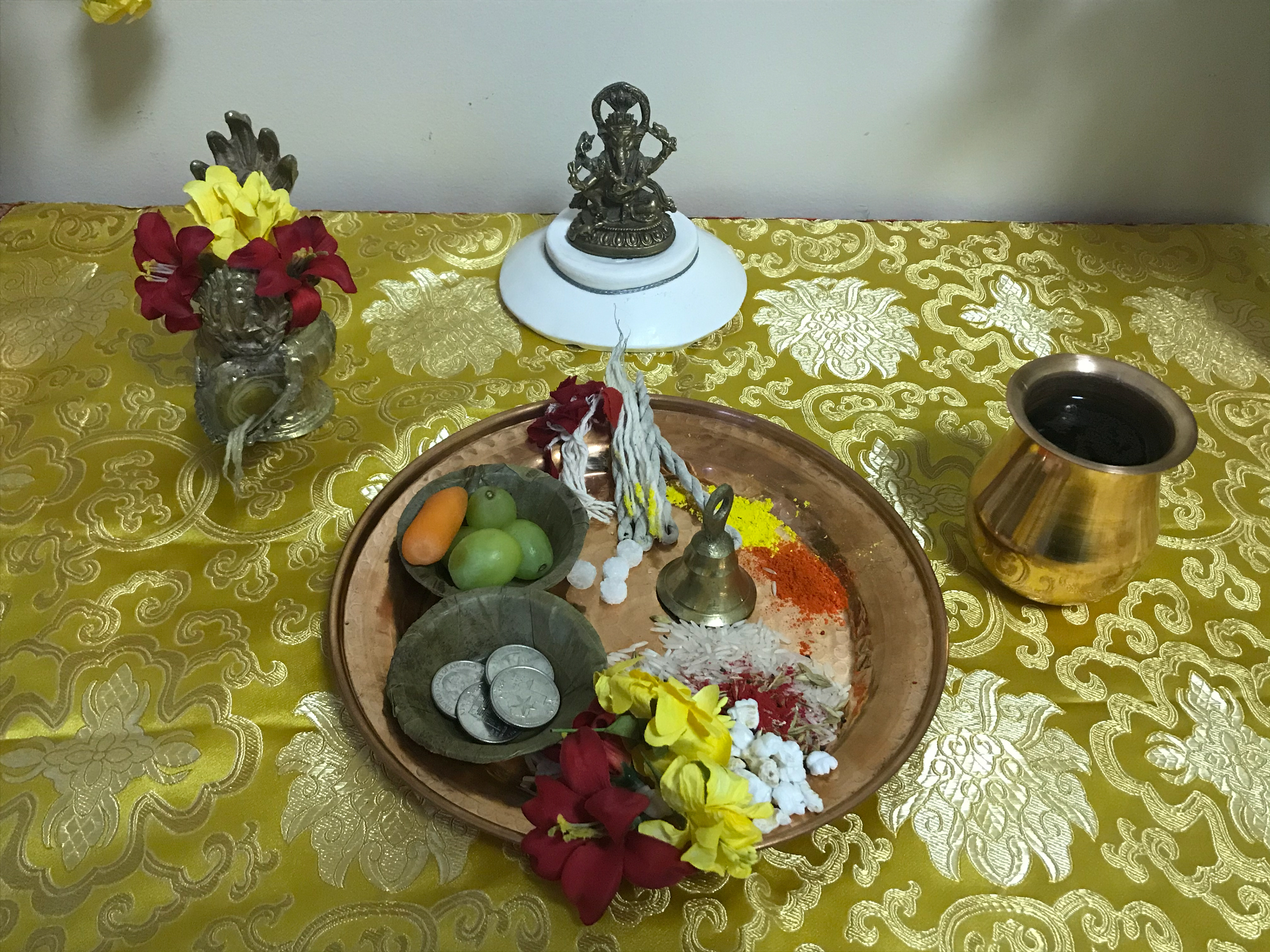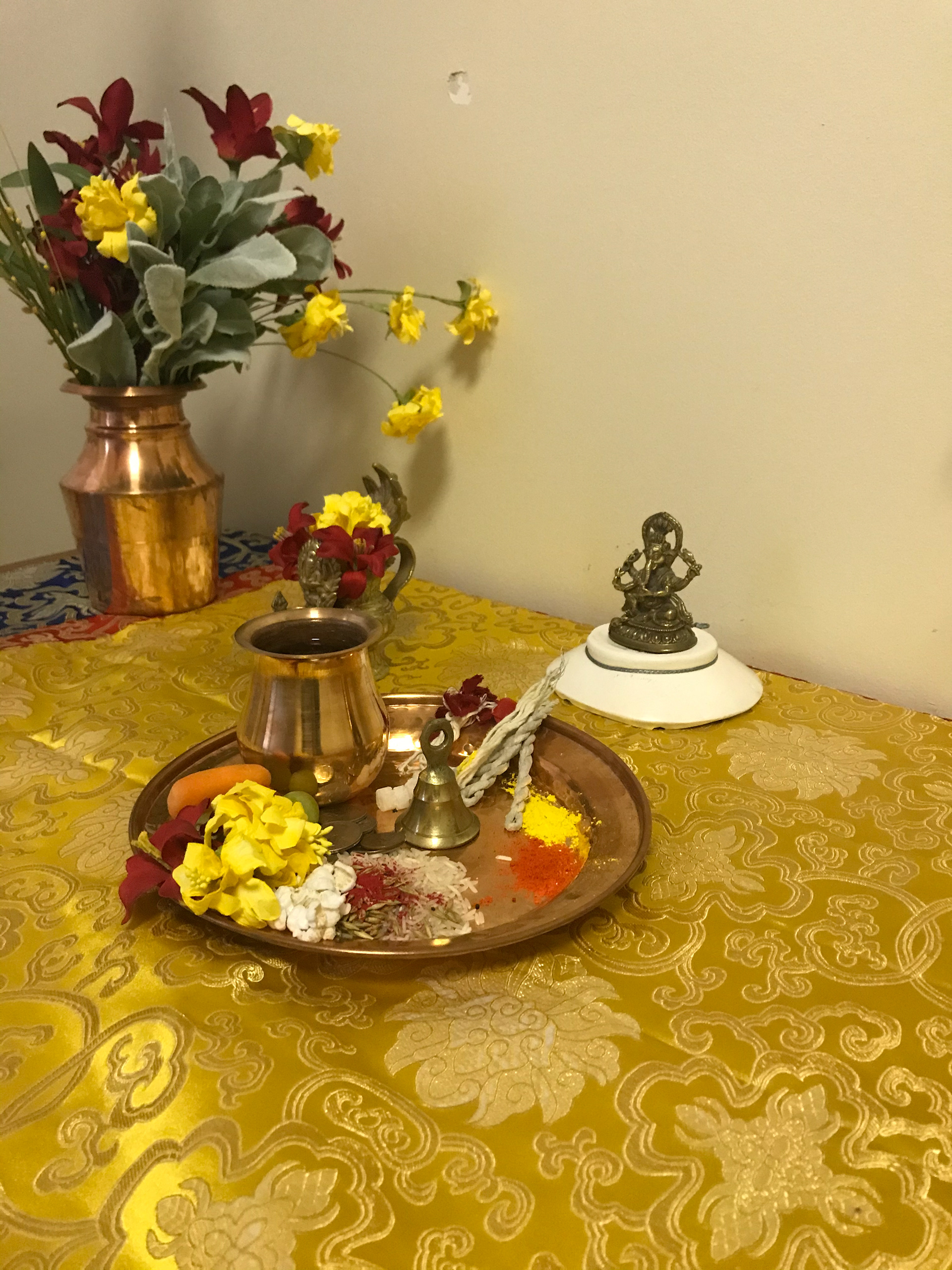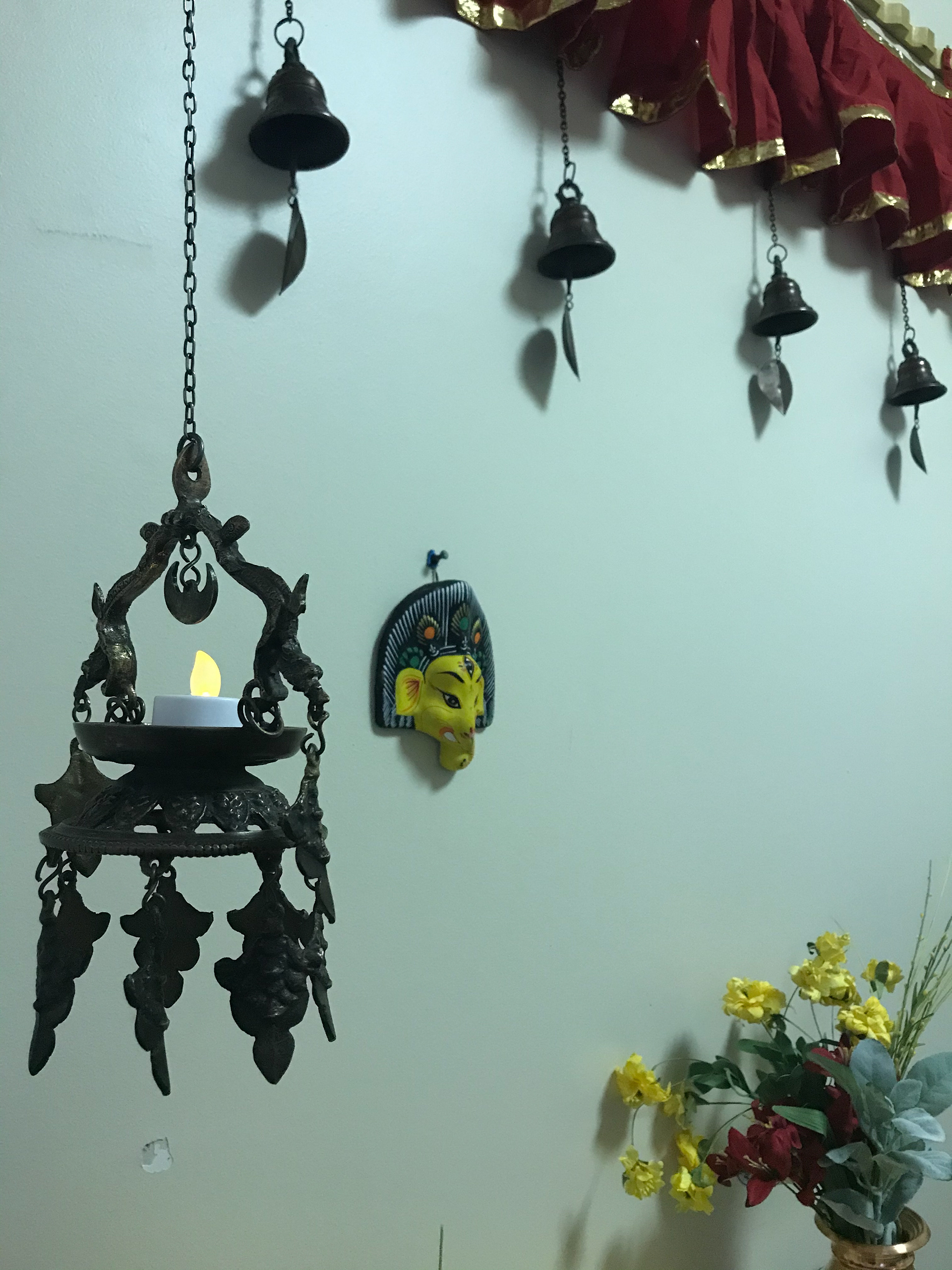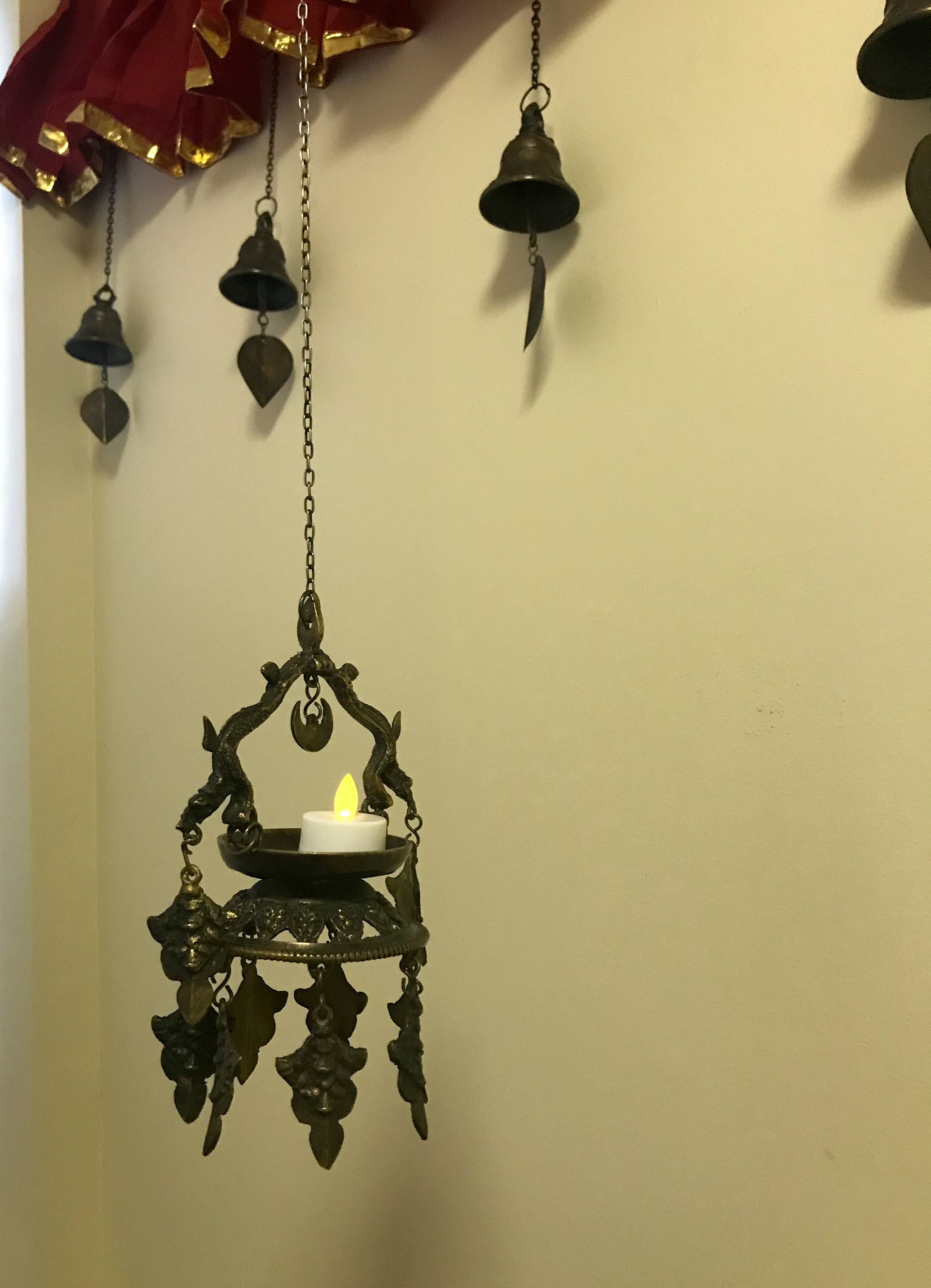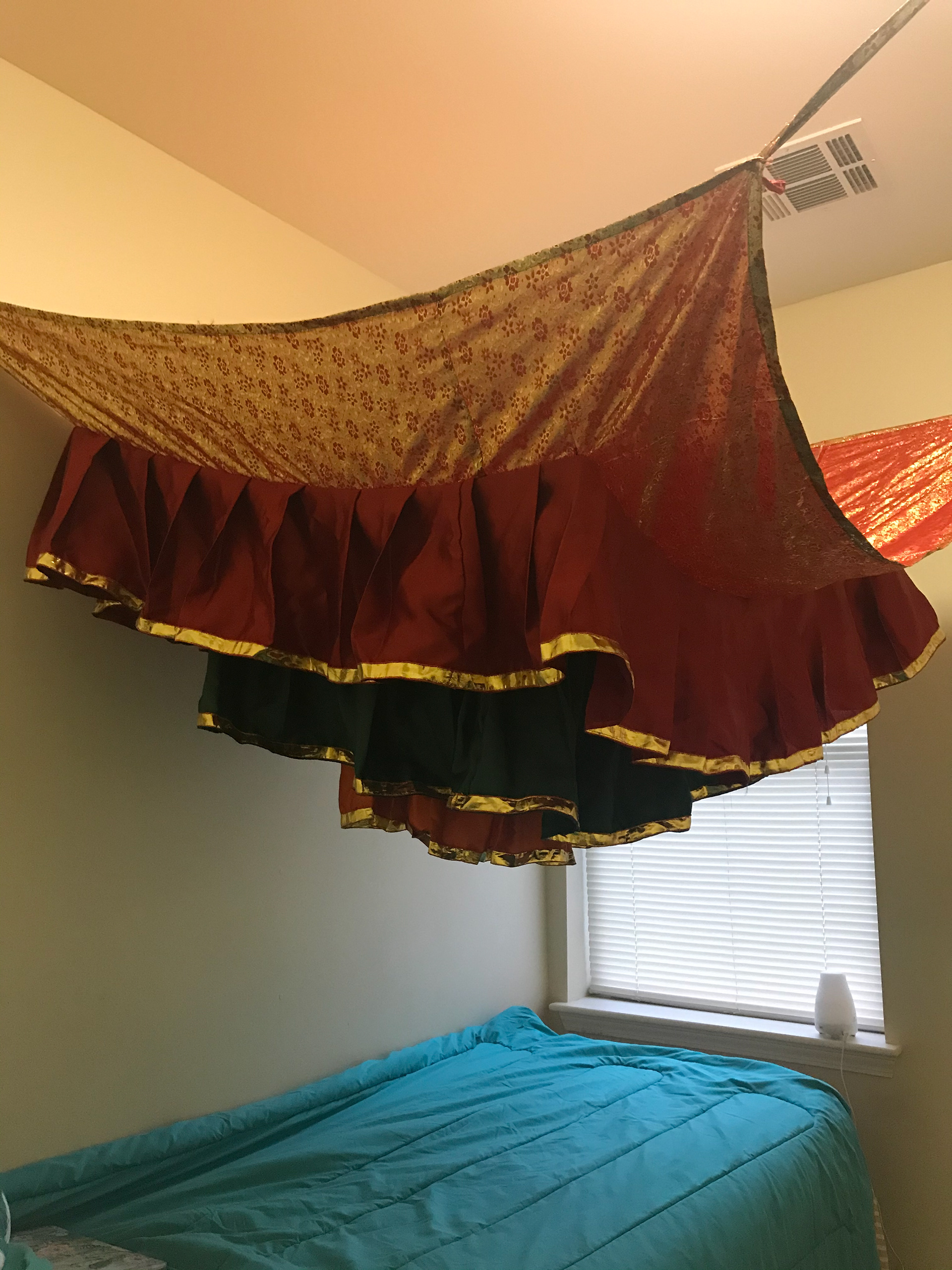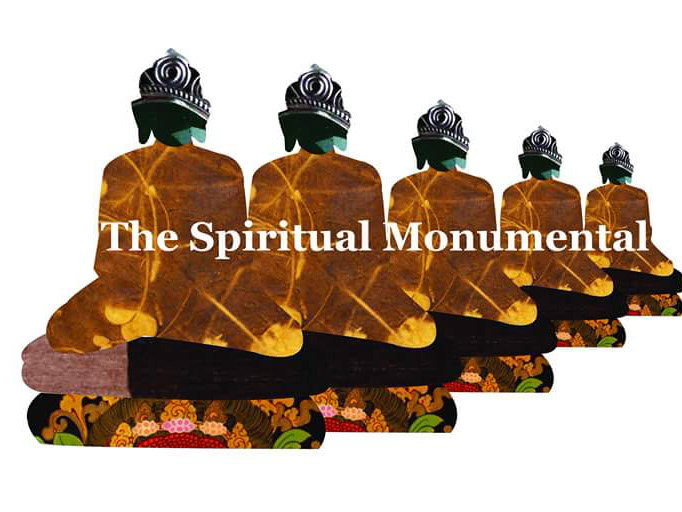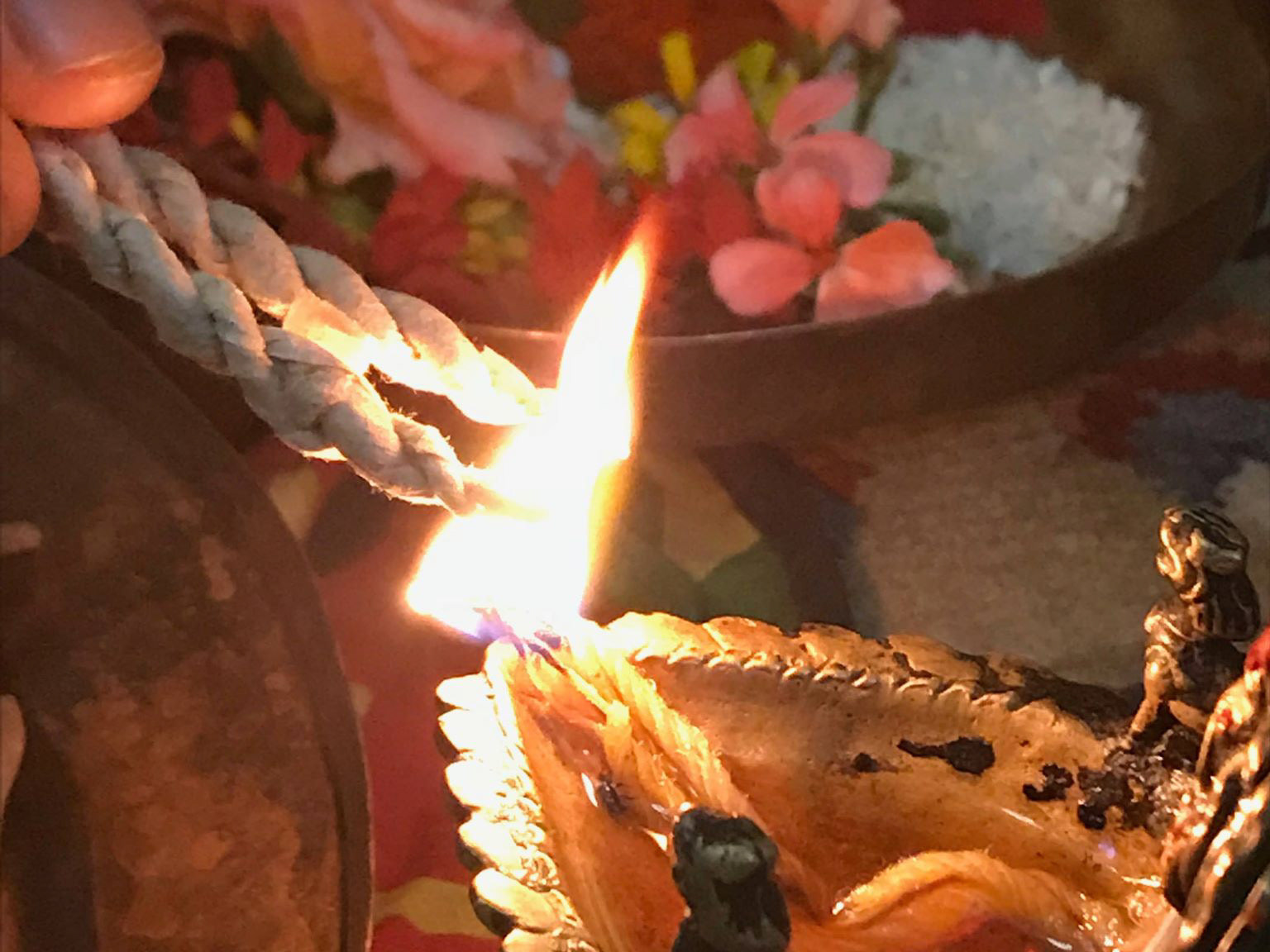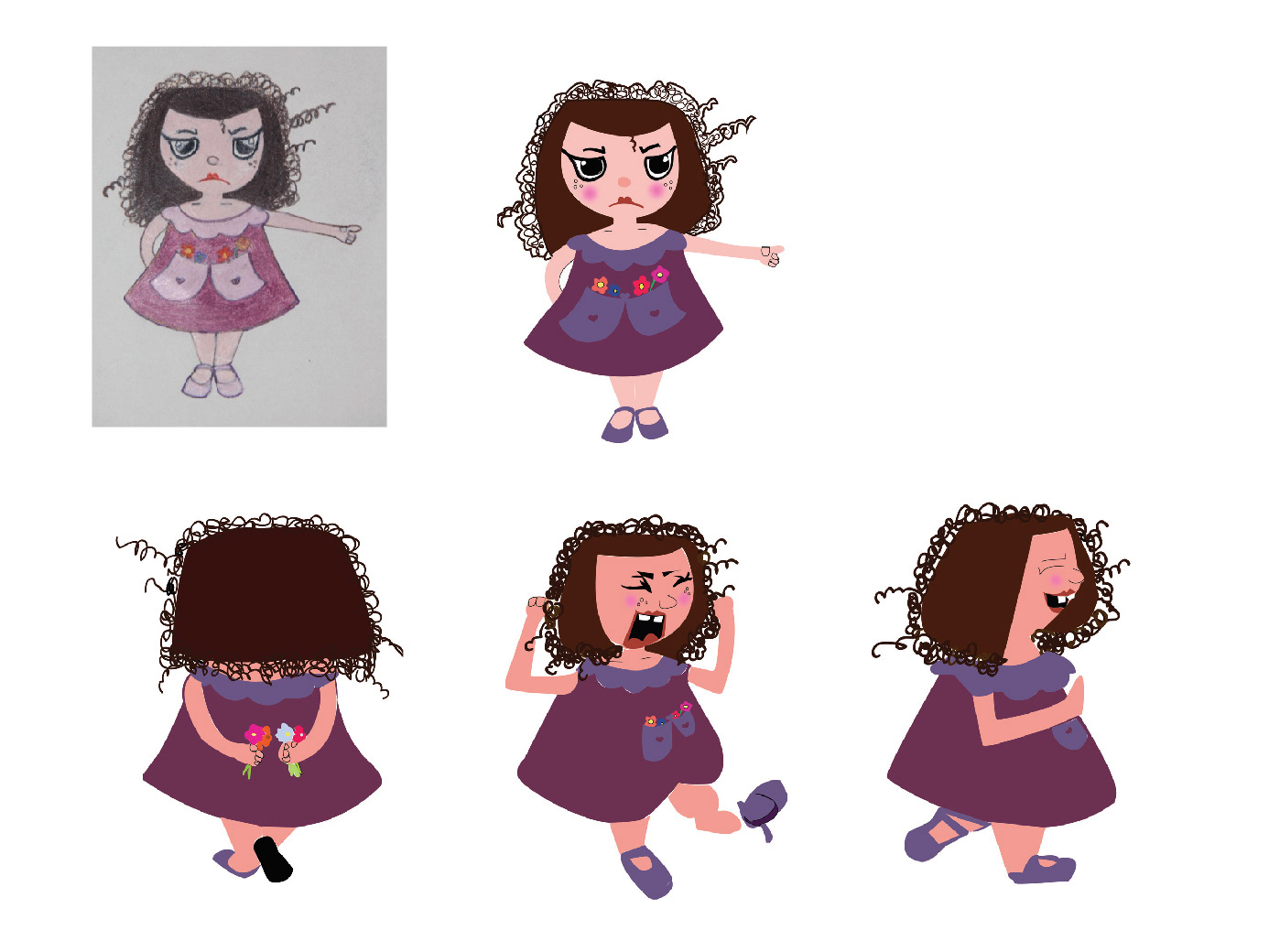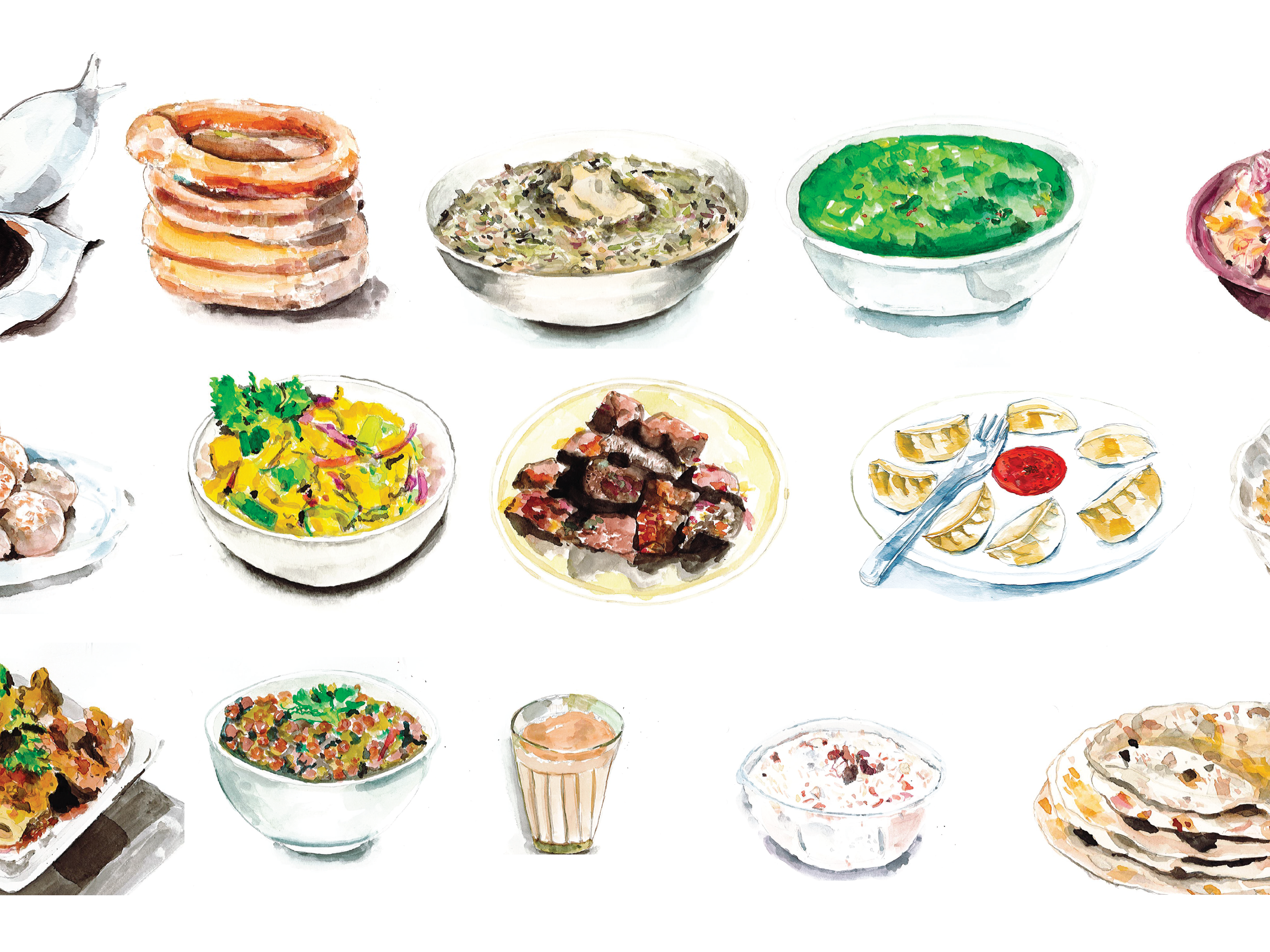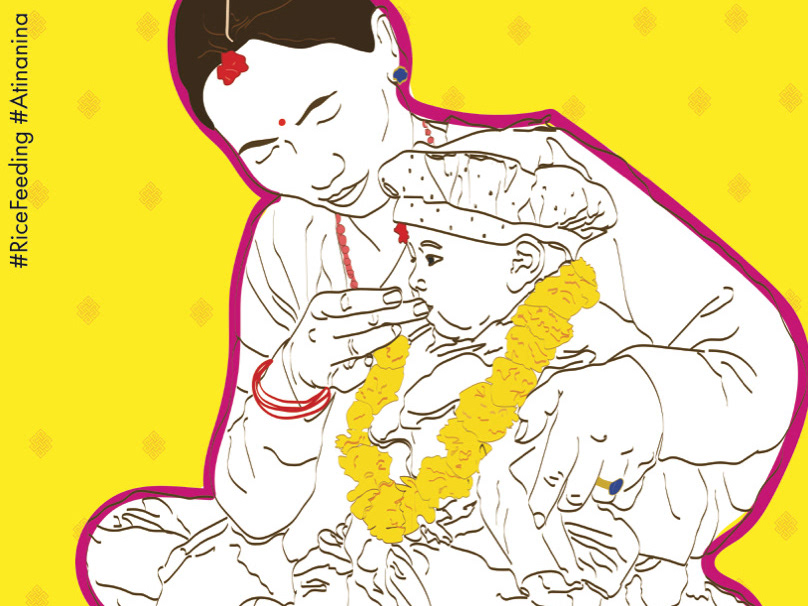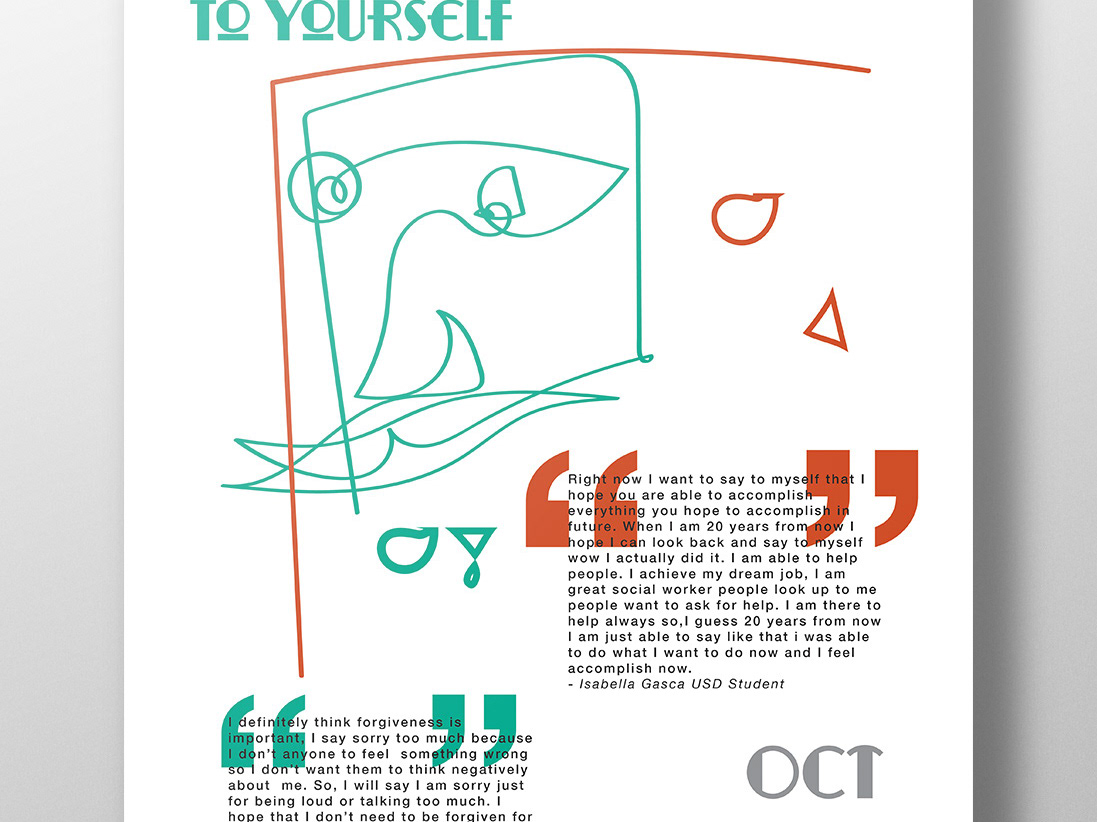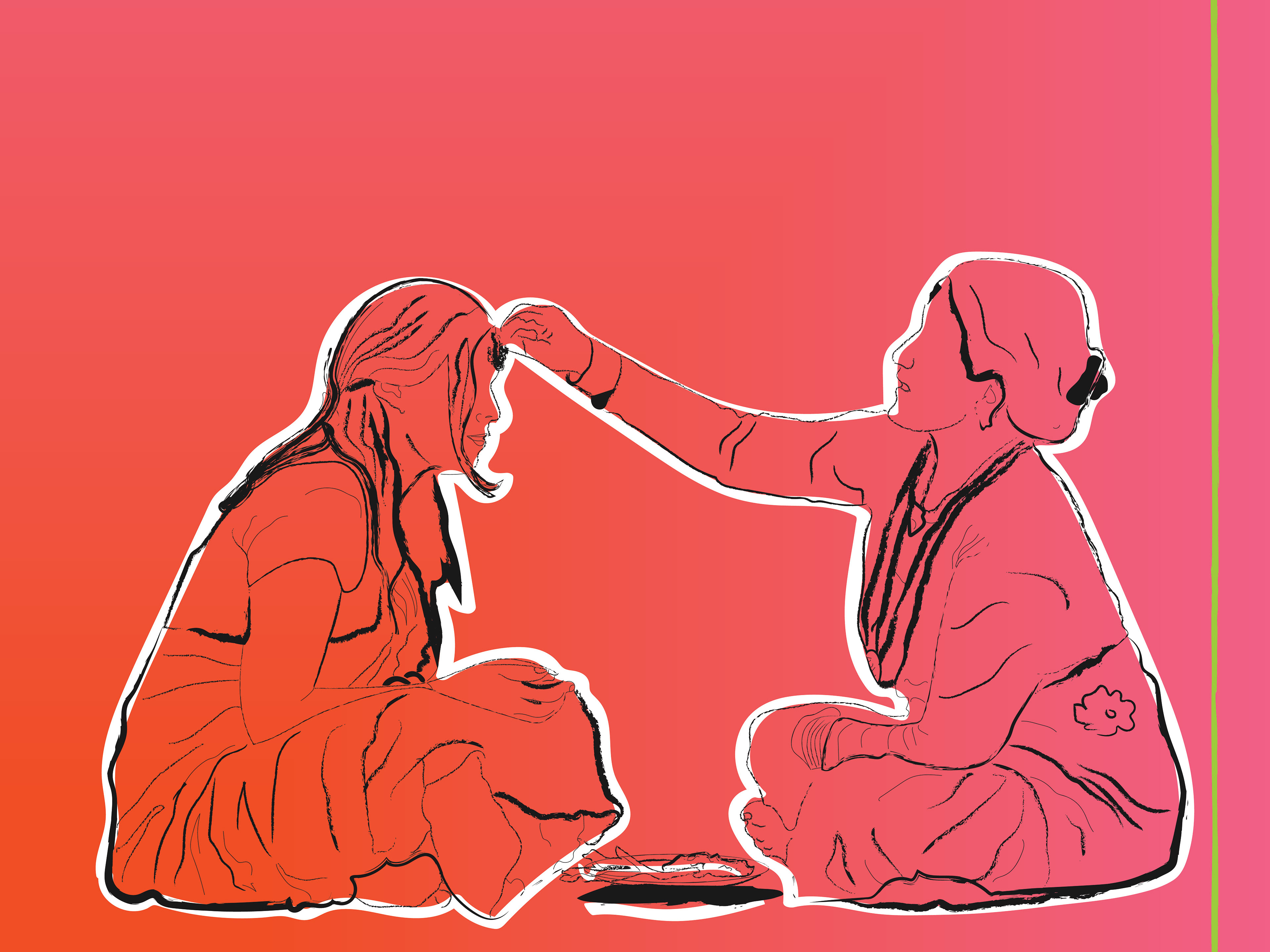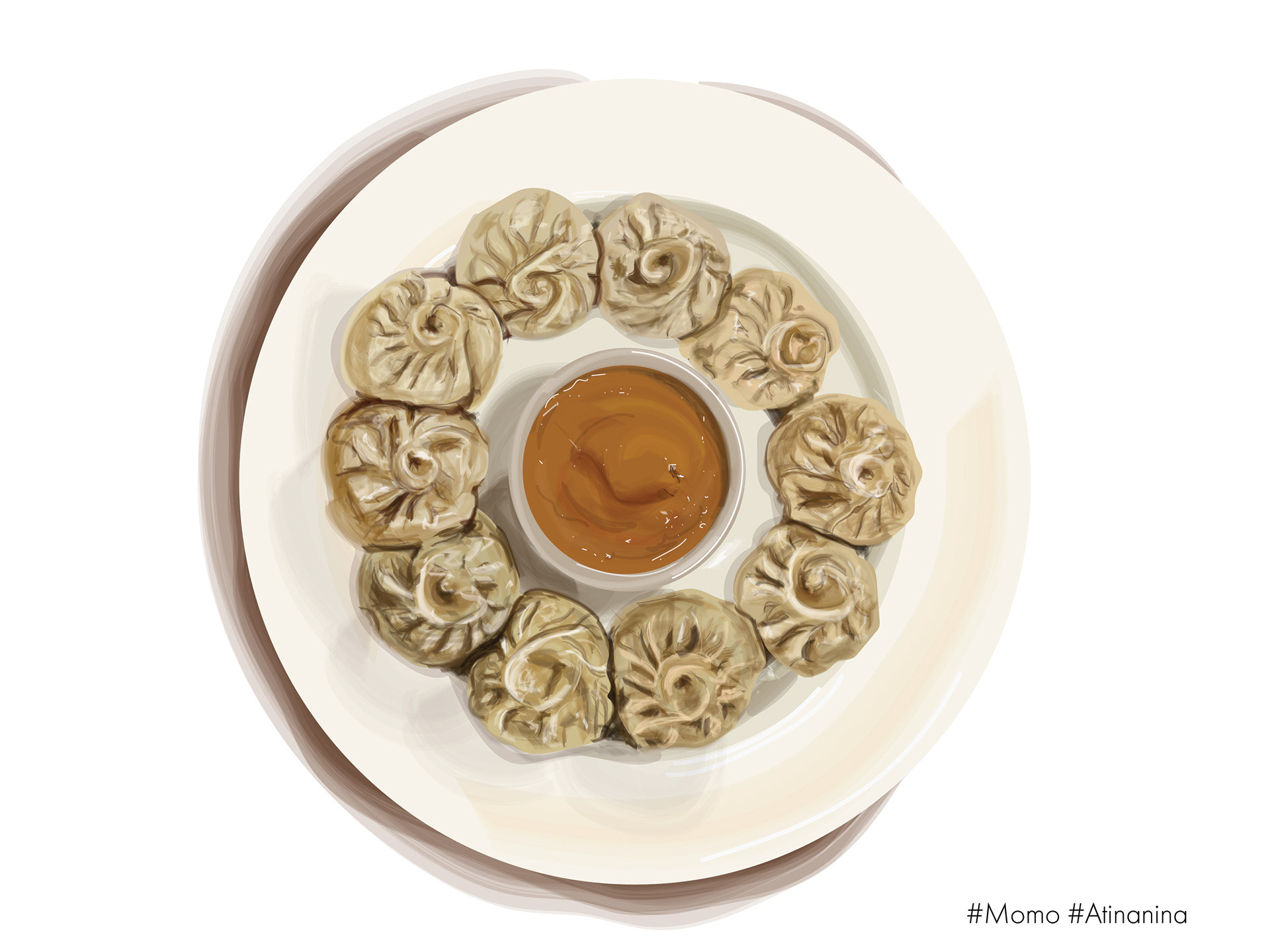Calendar Posters
2020
Digital
21” x 28.3 “
2020
Digital
21” x 28.3 “
Lunar Calendar & Cultural Festivals
This project explores Nepal’s lunar calendar and its influence on cultural festivals. It features twelve poster calendars highlighting major celebrations using ASTA-TYPE, a custom font I designed. Each poster includes a brief festival narrative and a QR code that links to related YouTube videos. The freehand digital illustrations capture the essence of these traditions, blending culture, design, and storytelling into a visually engaging experience.
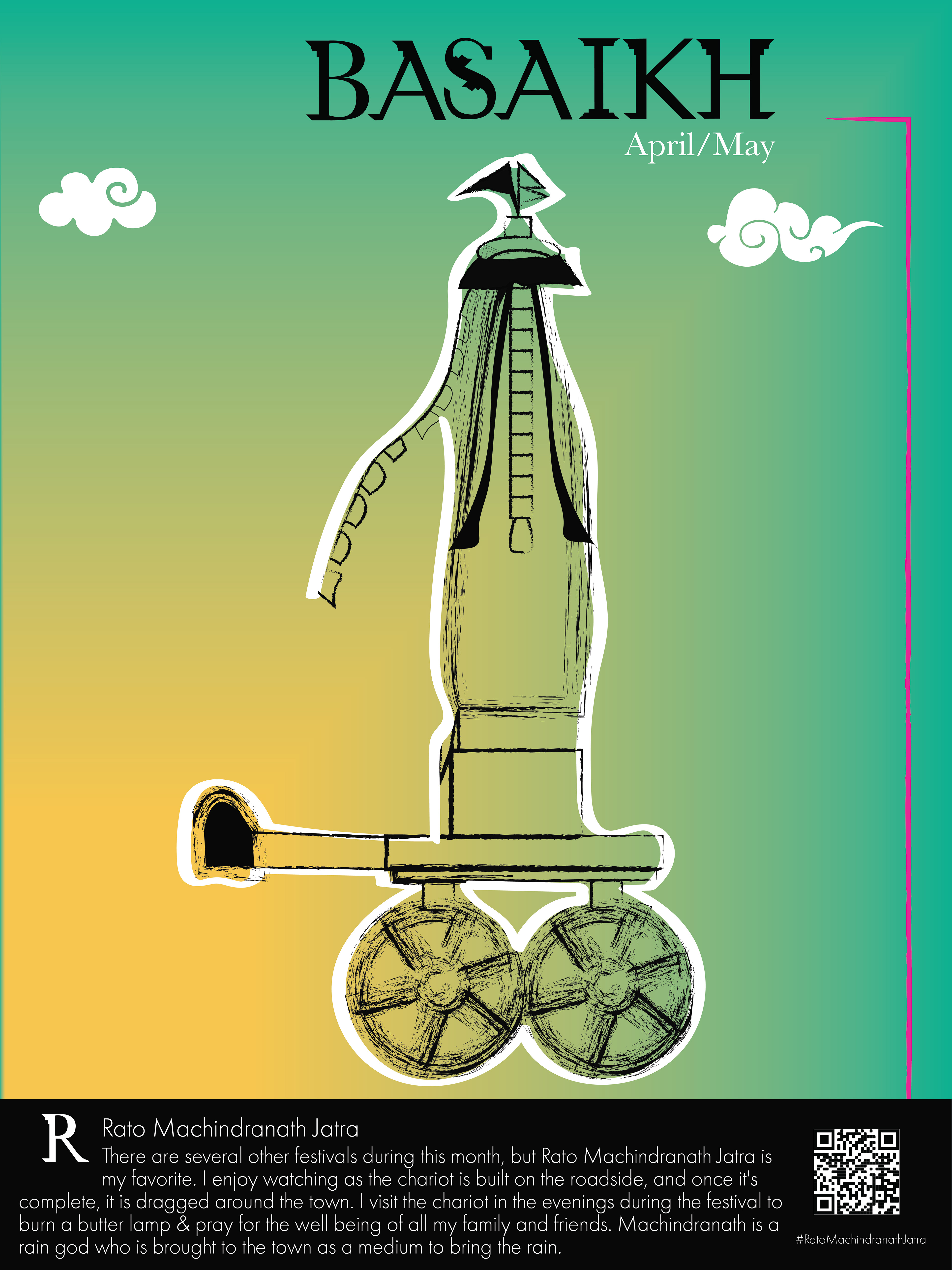
Basaikh
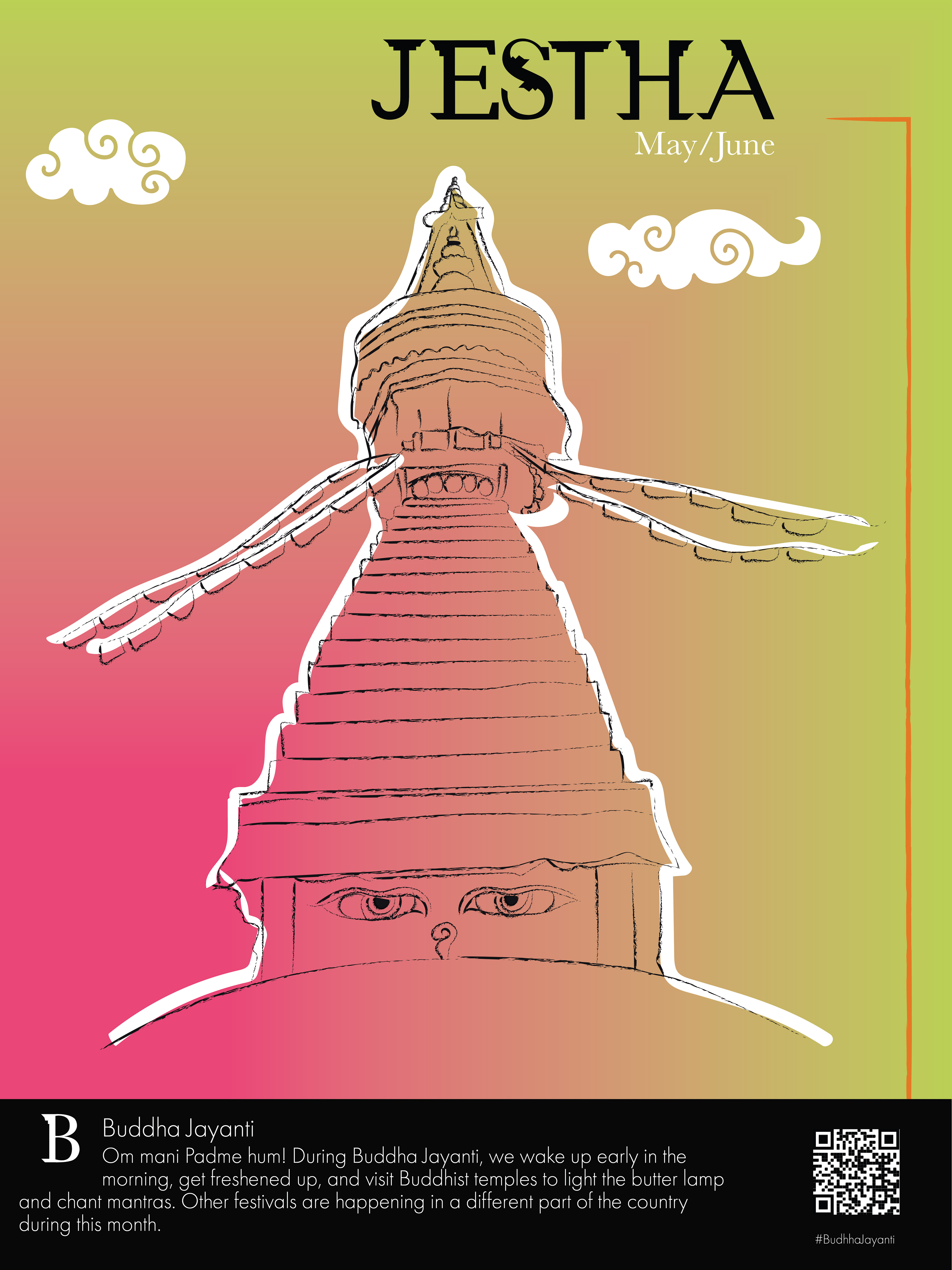
Jestha
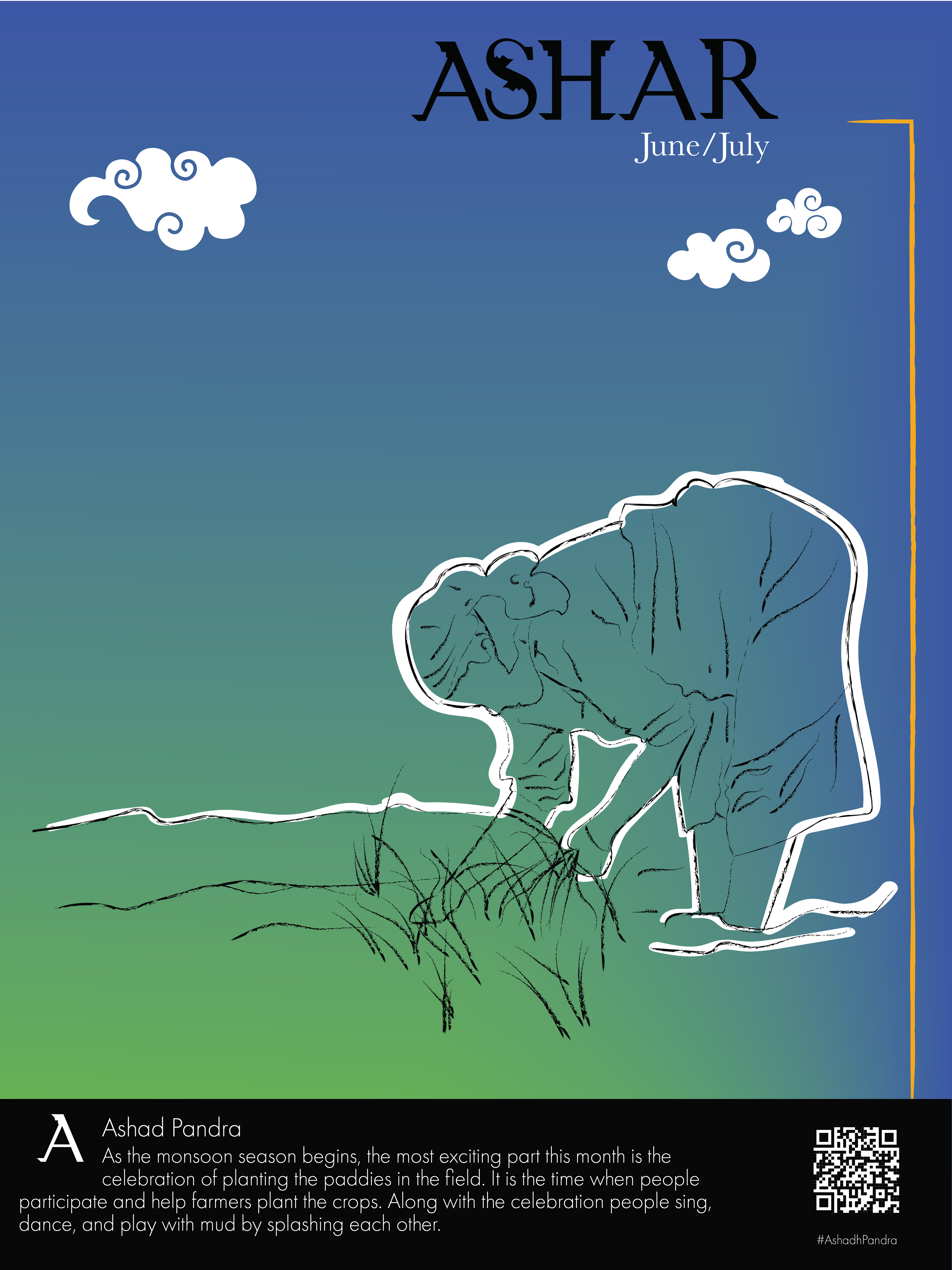
Ashar
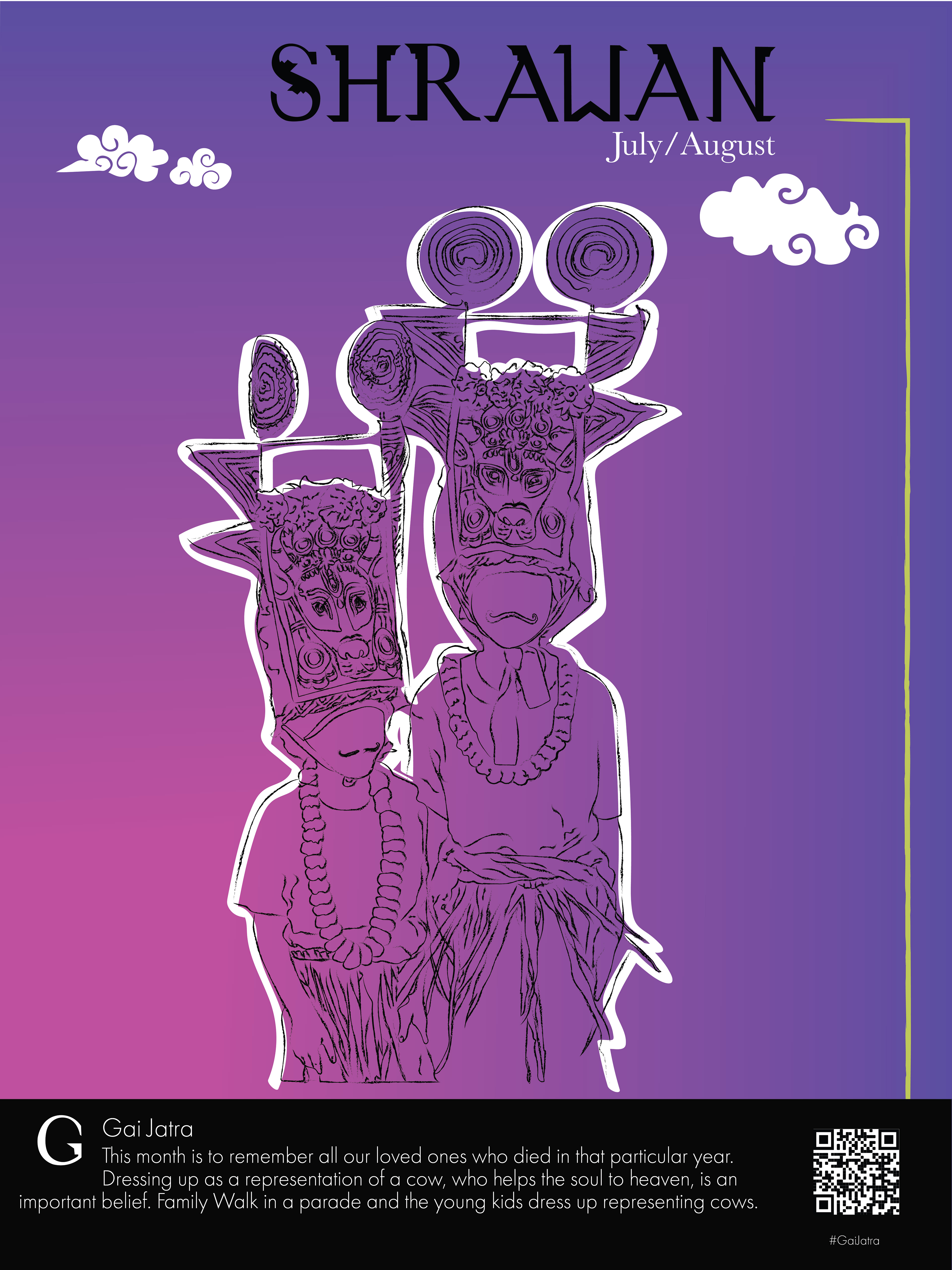
Shrawan
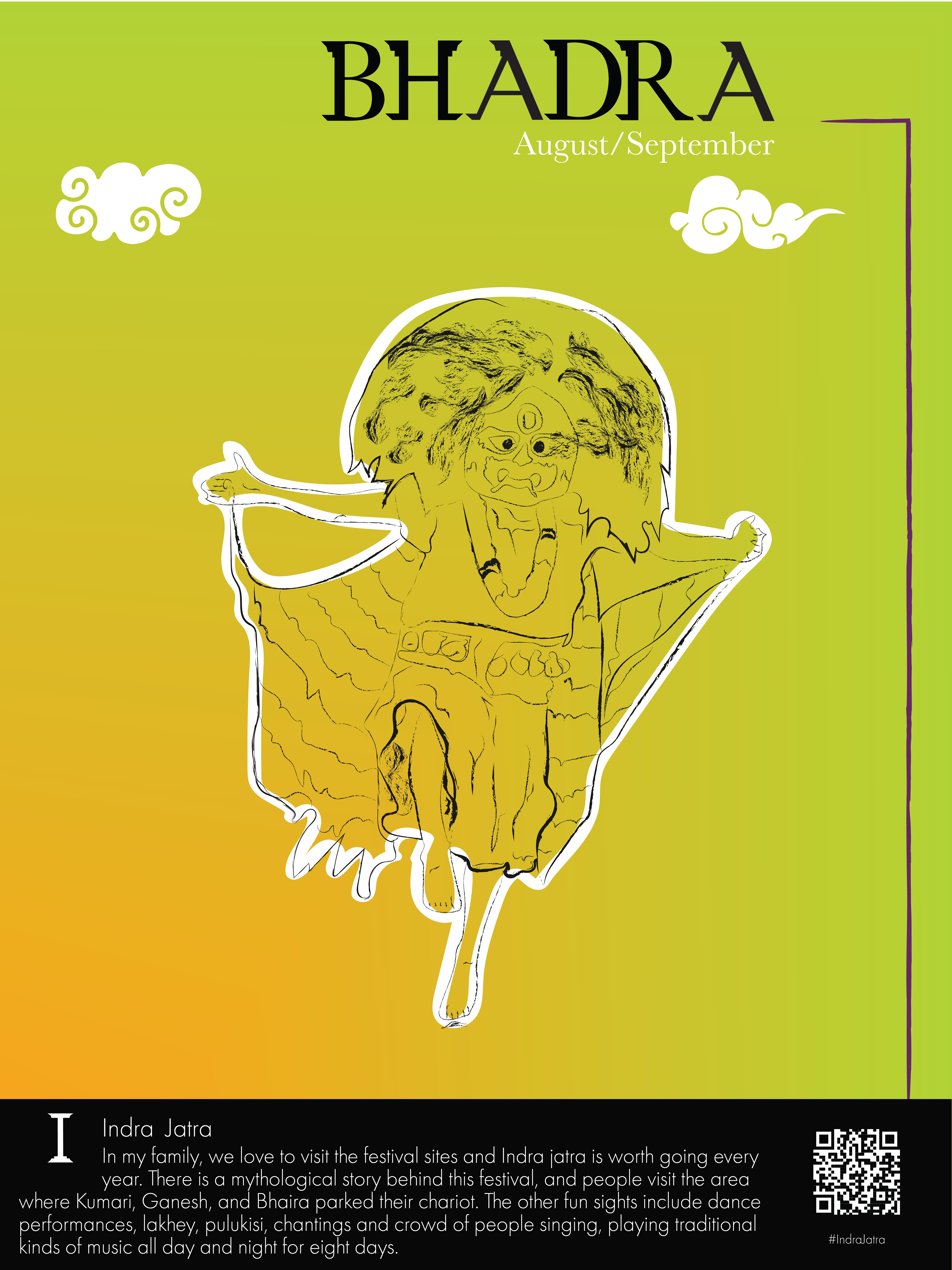
Bhandra

Ashoj
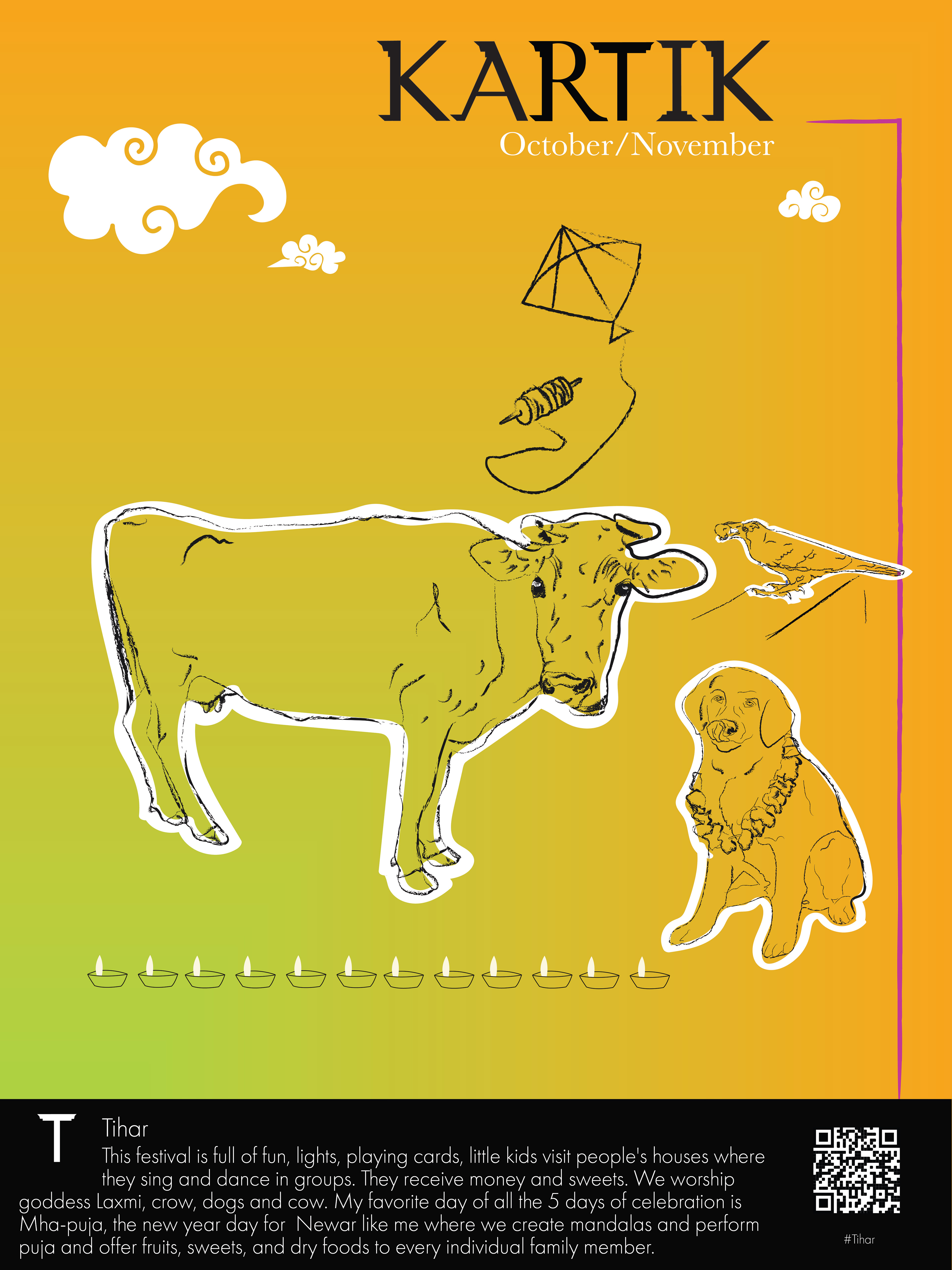
Kartik
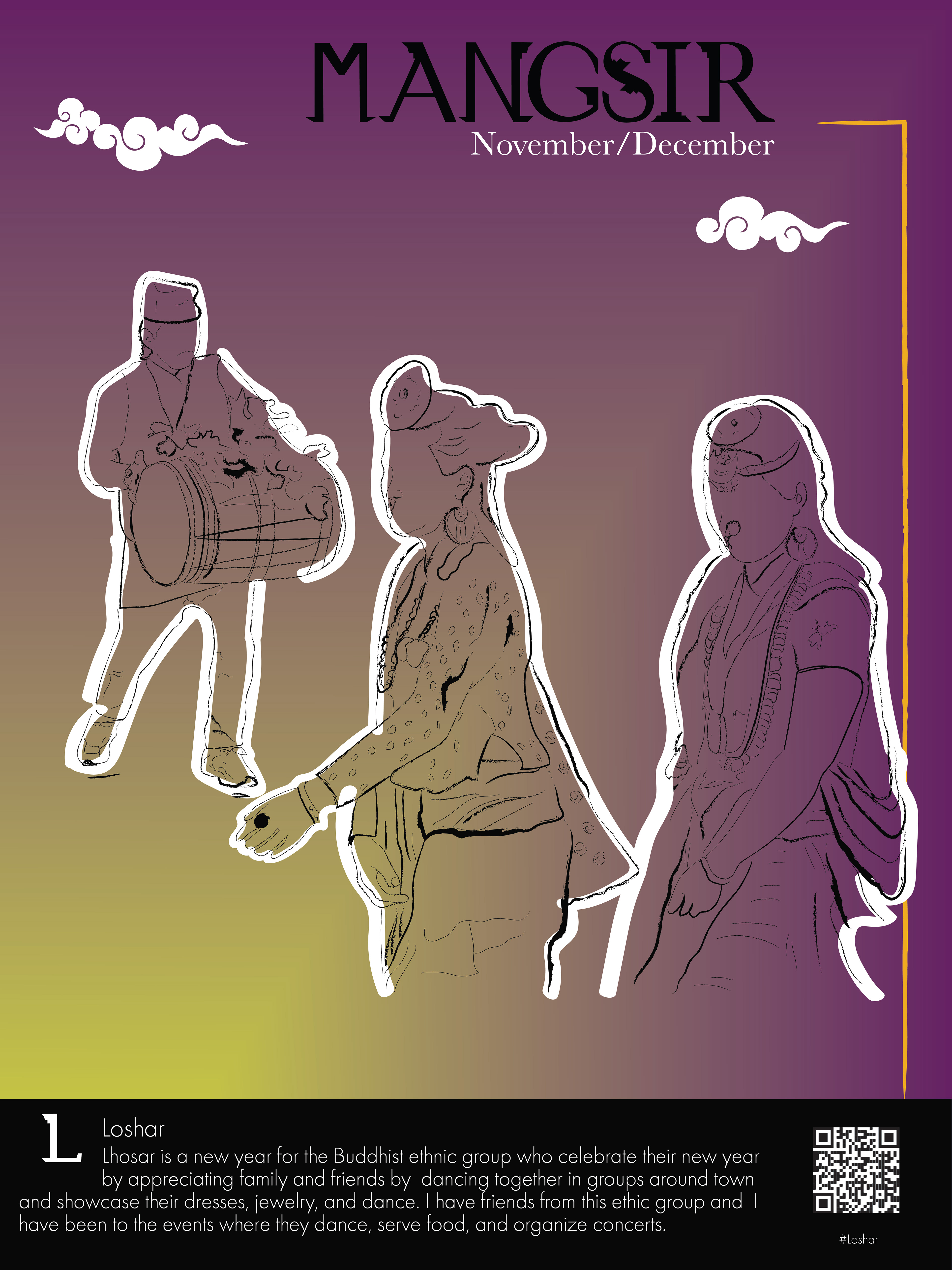
Mangsir
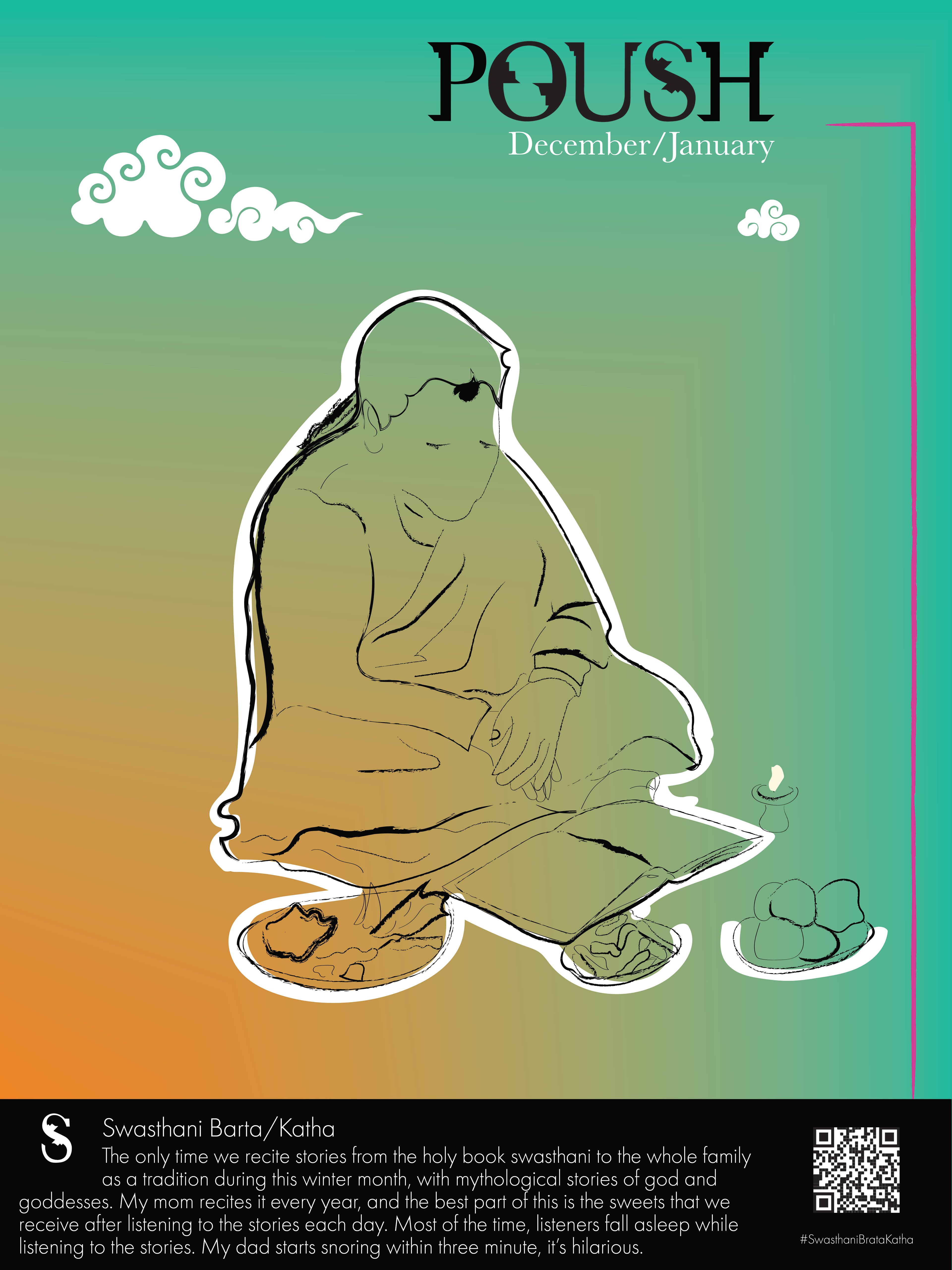
Poush
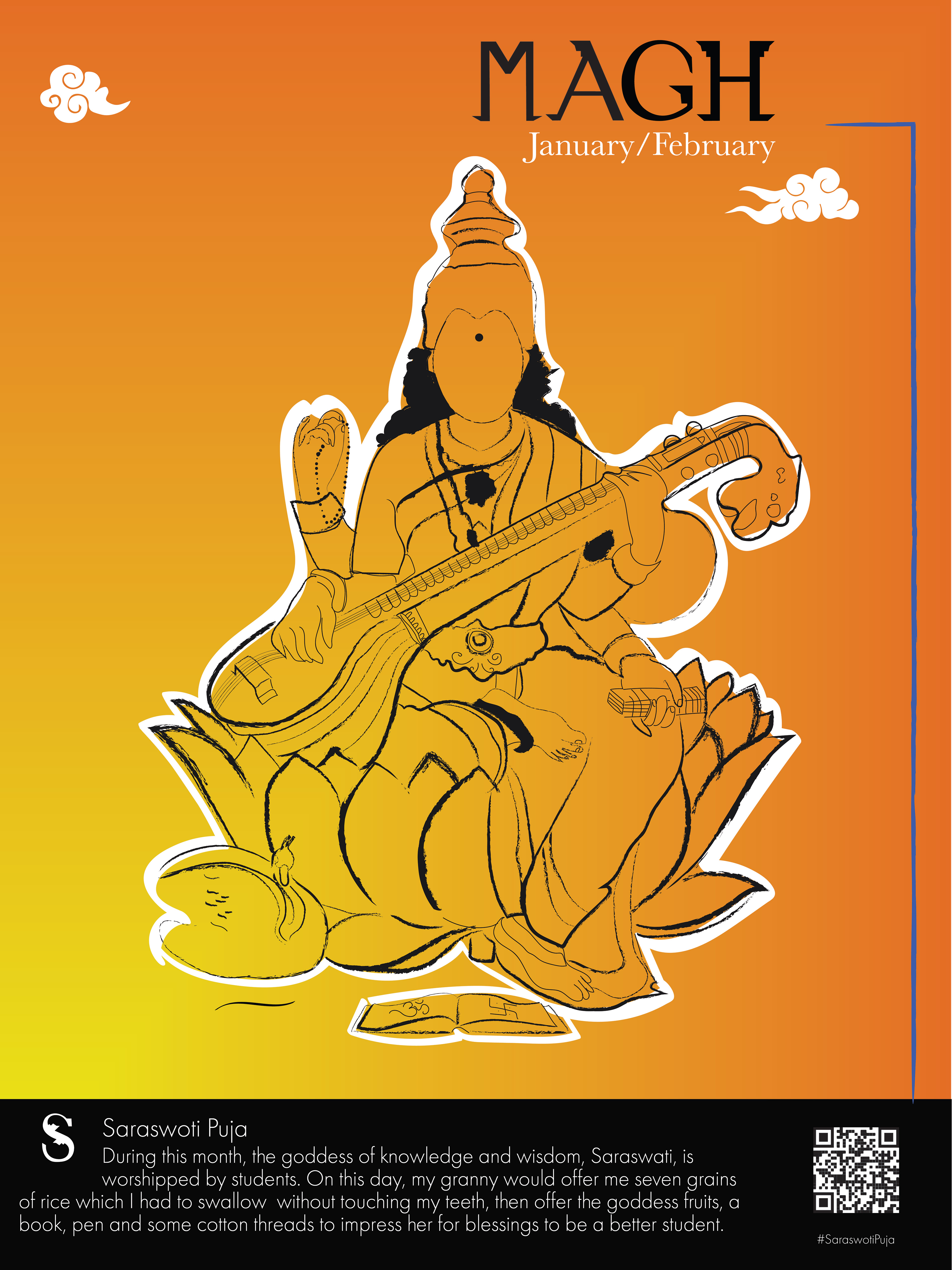
Magh

Falgun
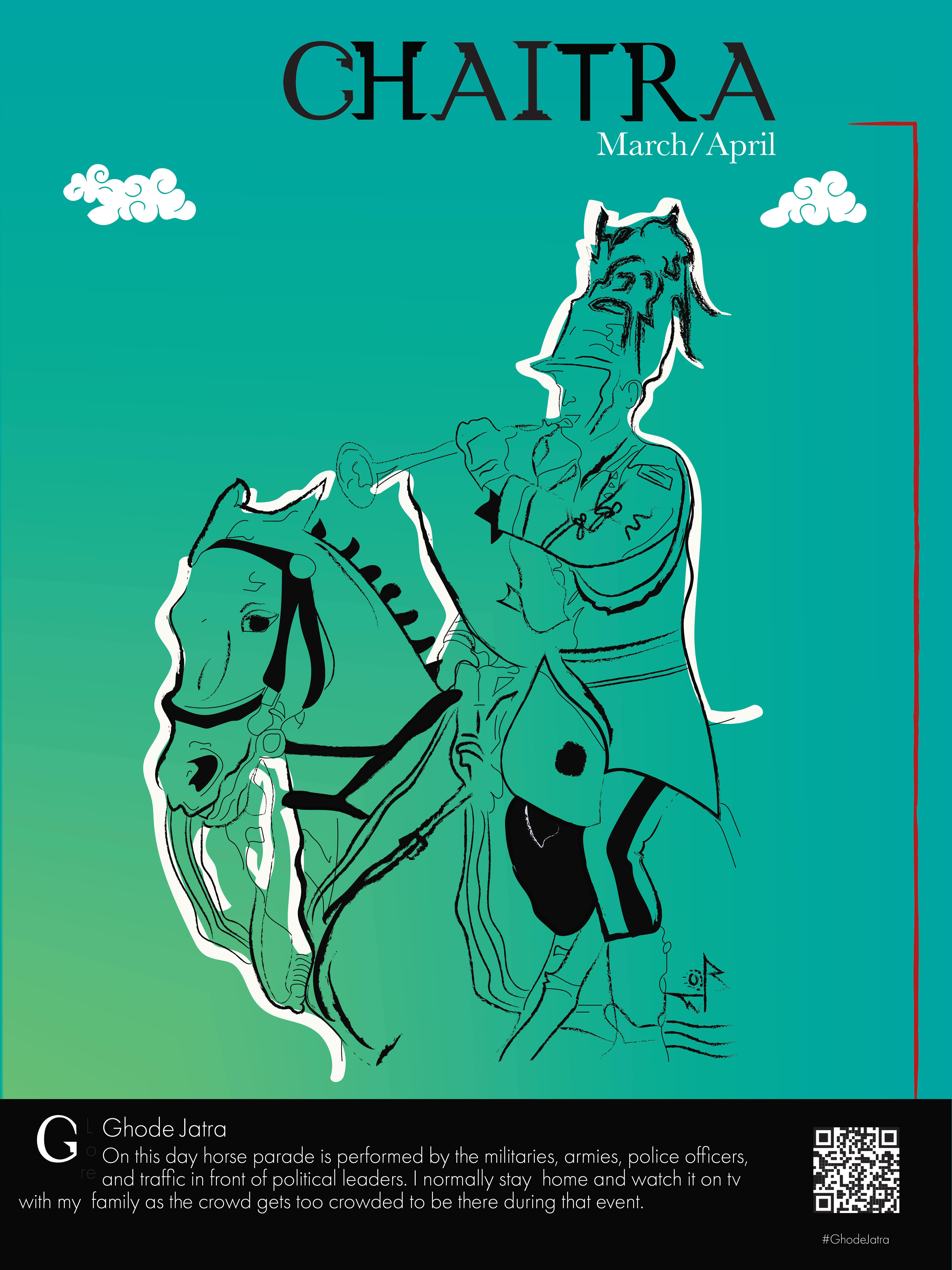
Chaitra
Foods Illustration
2020
Digital
12’’ x 9’
2020
Digital
12’’ x 9’
Culinary Heritage & Inspiration
Food is a vital part of our identity, connecting us to places, traditions, and memories. My love for cooking stems from my grandmother and mother, whose dedication to nourishing our family has been a constant source of inspiration. Their passion for creating everyday meals and festive delicacies reflects the deep cultural significance of food. For me, cooking is more than a skill—it’s a way to honor heritage, preserve traditions, and celebrate the moments that bring us together.
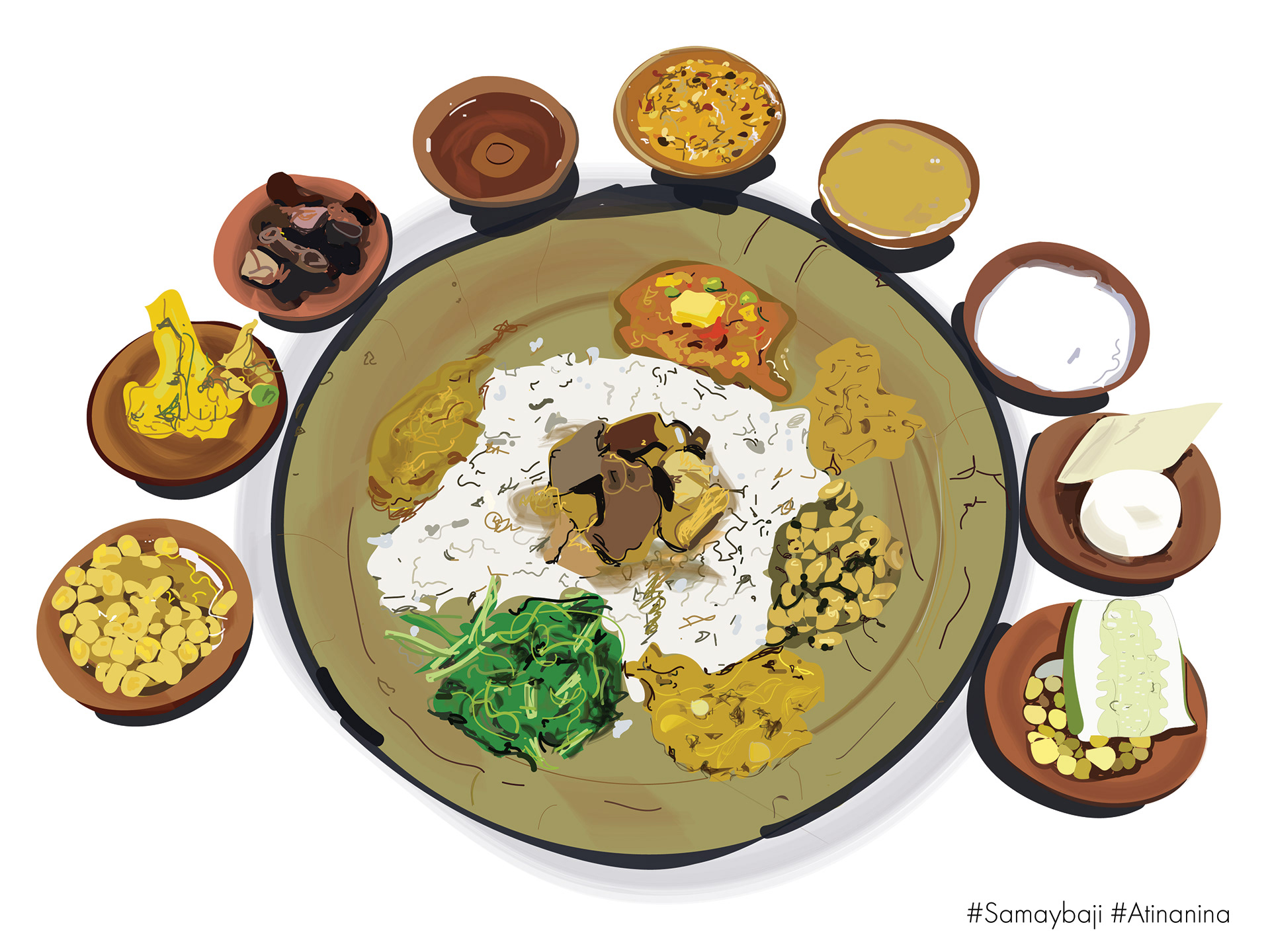
Samay Baji Foods are the identity to us as we counter the dish by its place, names, ingredients, and the recipe to make it. I love cooking and enjoy cooking them as I learn it from my granny and mom. It is special to me because it fills in with memories and nourishment from them.They are the most inspirational and motivated cooks I have ever seen in my life who continuously cook every day for all of us and prepare some unique dishes for the occasions. They are the warriors of the family who save us by feeding and nurturing us, at least in my life. They are unique, and when there are festivals, there is always food, a lot of food.
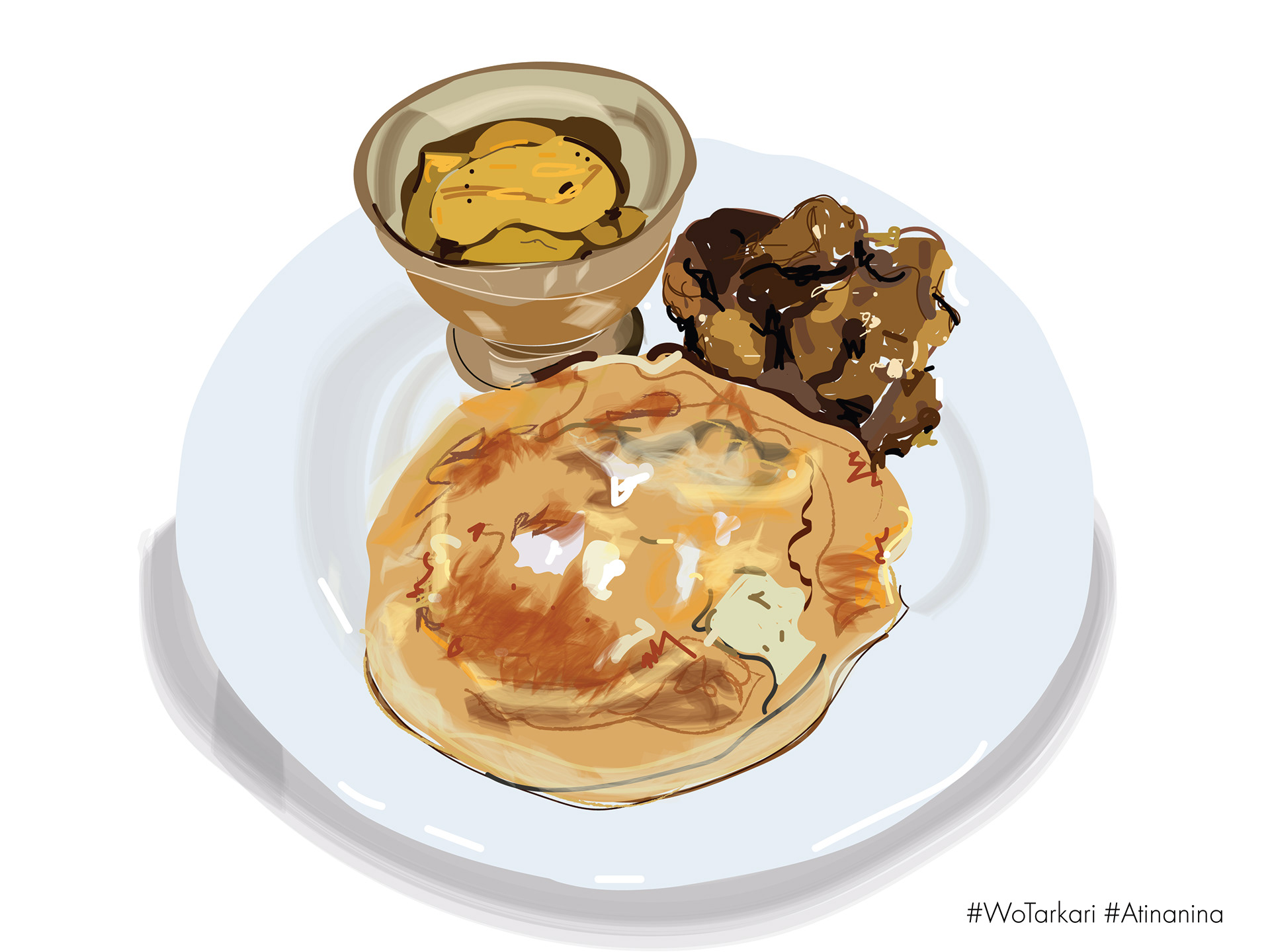
Wo/Bara – I miss the wo made by my mom, it is a black and green bean pancake made during special occasions served as a set with eggs, fish, ginger, garlic, mean, and yogurt. We get the whole set of items on our birthdays too. In the month of Jestha chatamari, a thin tortilla like bread of rice flour is also served with black bean pancakes. Family prepares and invites relatives to eat them together. My grandfather used to enjoy chatamari as it is very soft and light weight eaten just like that without anything.
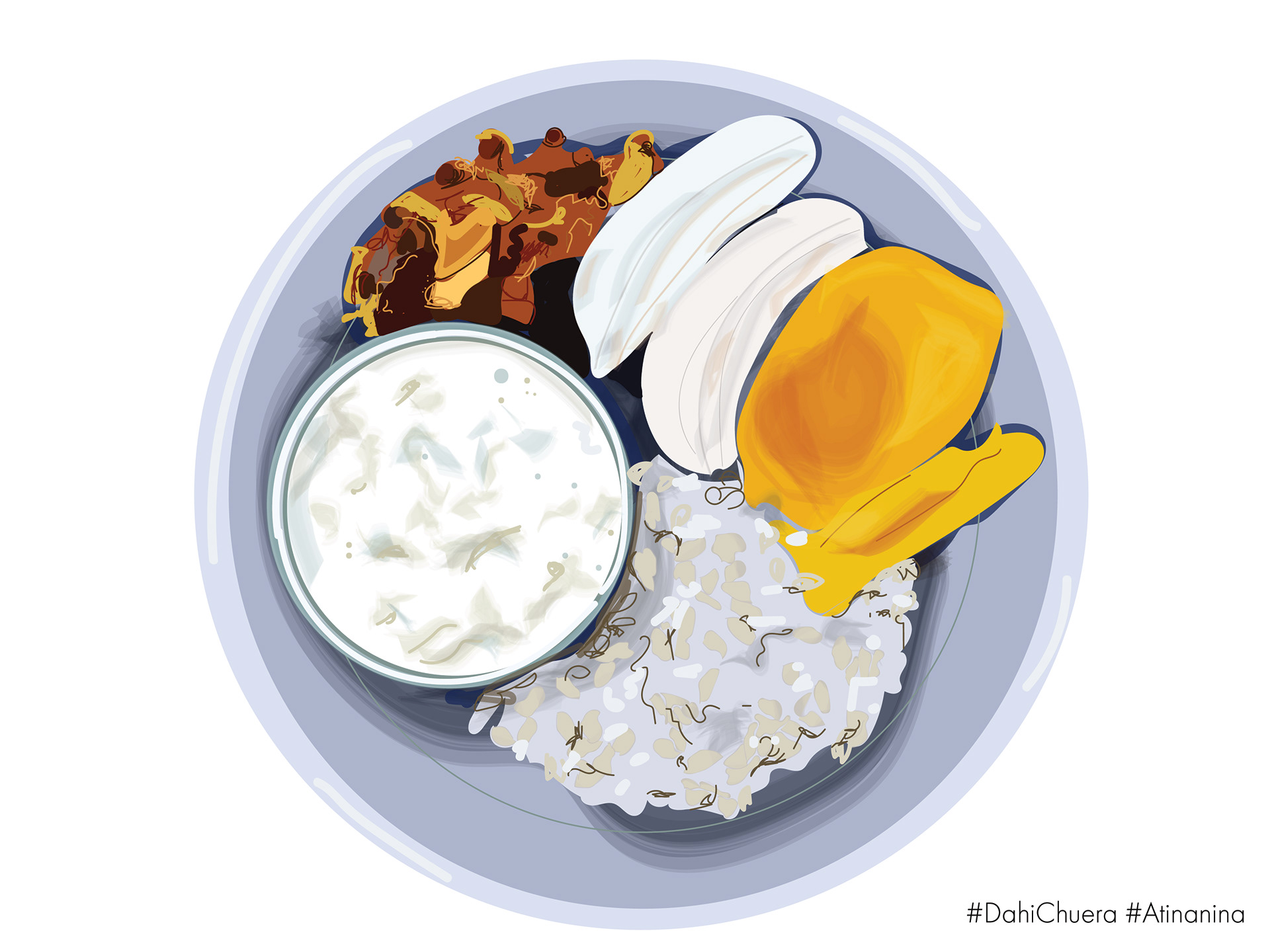
Dahi Chura – During the time of planting the paddies, we normally don’t go to the field to play with mud because my granny was against it because she thought we would catch up cold. We would celebrate by eating yogurt and beaten rice with sugar and fruits. I prefer some sugar with the yogurt and the mangoes go best with it.
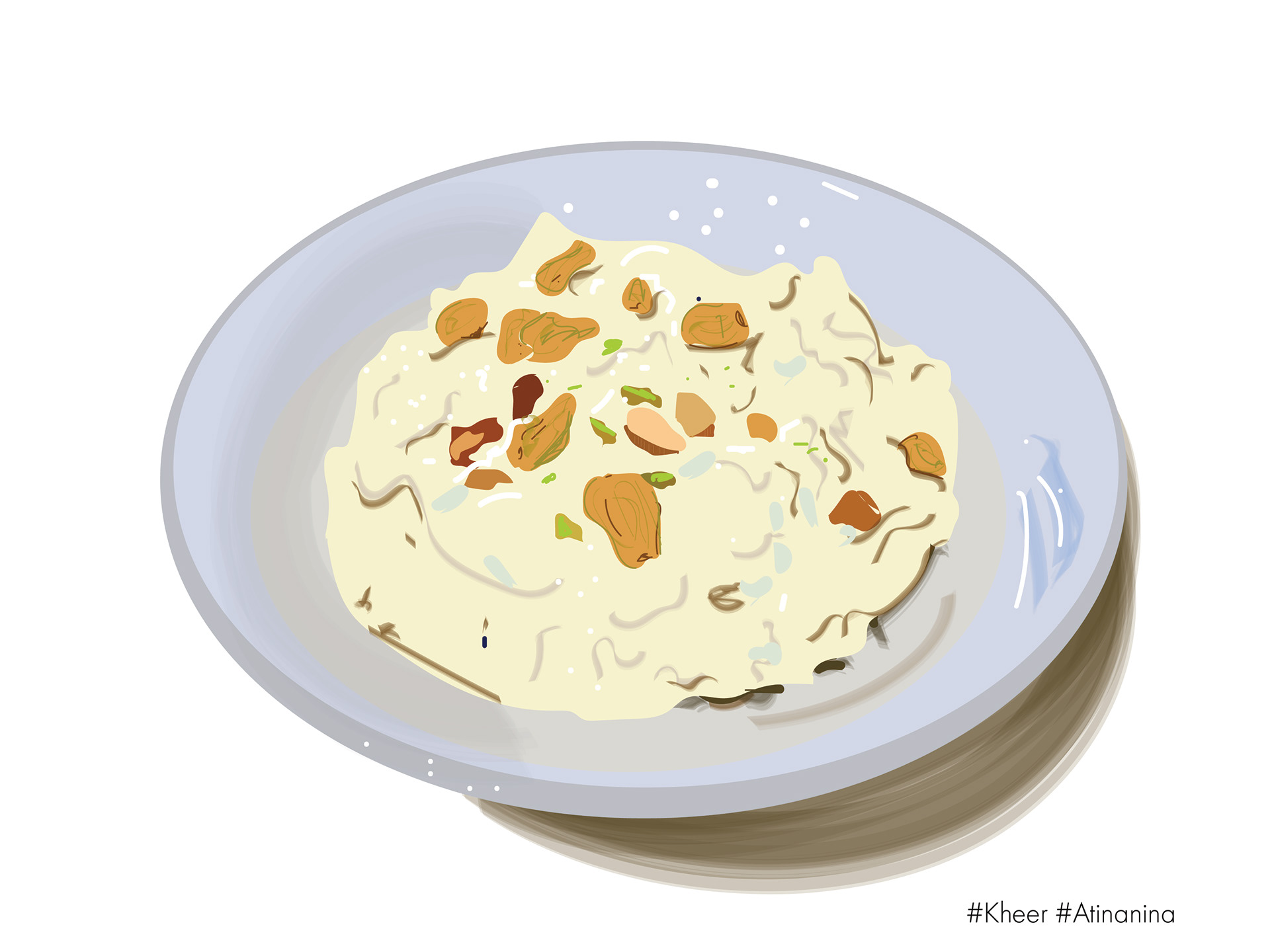
Kheer - It is a sweet dish prepared with milk, rice, and dry fruits. Usually eaten any time but the time of Shrawan, people fast for the month, and they prepare eating Kheer also called as rice pudding. My mom used to prepare them whenever one feels like eating it but it is always prepared on the time of monsoon and breaks our fasting with rice pudding and fruits. I using like a lot of raisins in my kheer with a pinch of saffron.
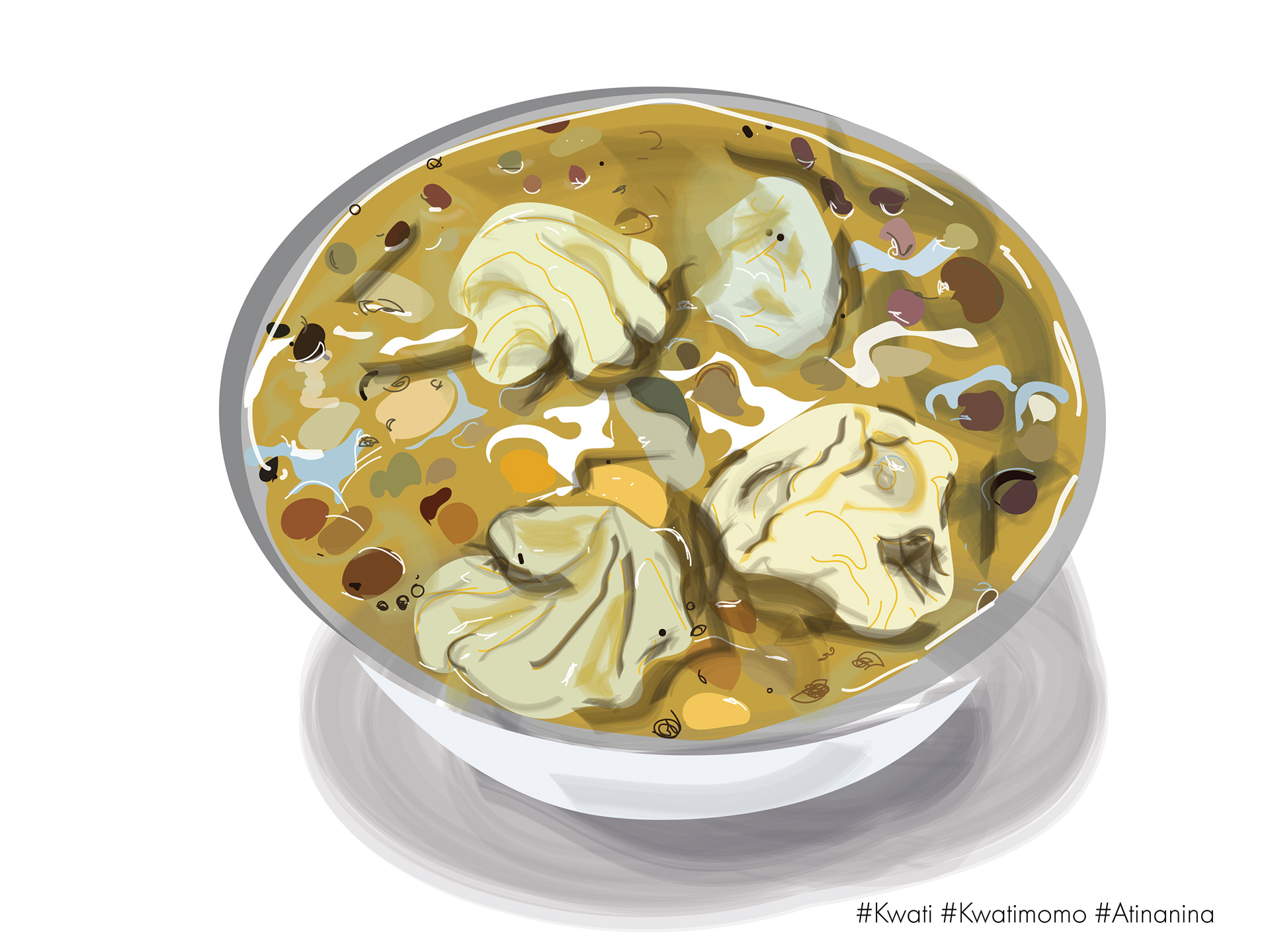
Kwati With Momo - The mixture of twelve beans prepared with spices like garlic ginger as a soup, and once cooks add the hot ghee with parsley seeds in the pot. We in our kitchen make huge mom with wheat flour to thicken the soup and dump some into it. And some we just eat with chill sauce. I love these kinds of momos and prefer the soup over the beans. There is a ritual of saying this every single time we are at the dining table every year this month; ah! kwati is the best and all the summer mosquitoes will disappear now and time to warm ourselves to prepare for the winter season. We also prepare it on rainy cold days served hot with some spicy chili sauce on the side.
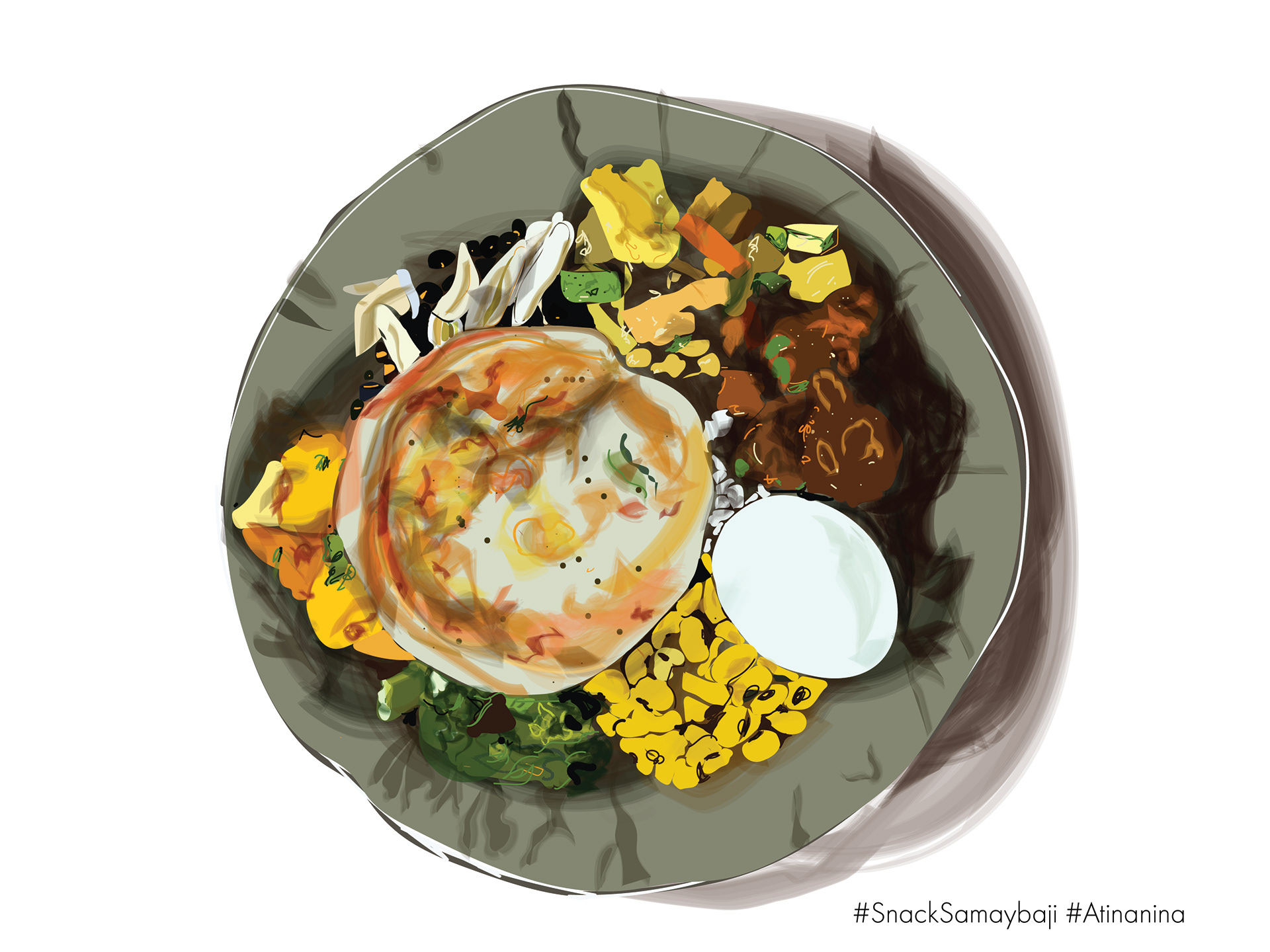
Samay/Khuchi bhoye - I like this mini version of the Samaj baji eaten as a snack in various festivals as a feast. While eating this food, there is no allocation of the seats in a hierarchical way, like how people do while eating samaj baji. It consists, beaten rice, black beans pancakes, blackeye peas, ginger, garlic, potato, egg, other beans, pumpkins curry, meat, fish, leaf curry, and barley alcohol. It is served in a bowl leaf stitched with thin sticks.
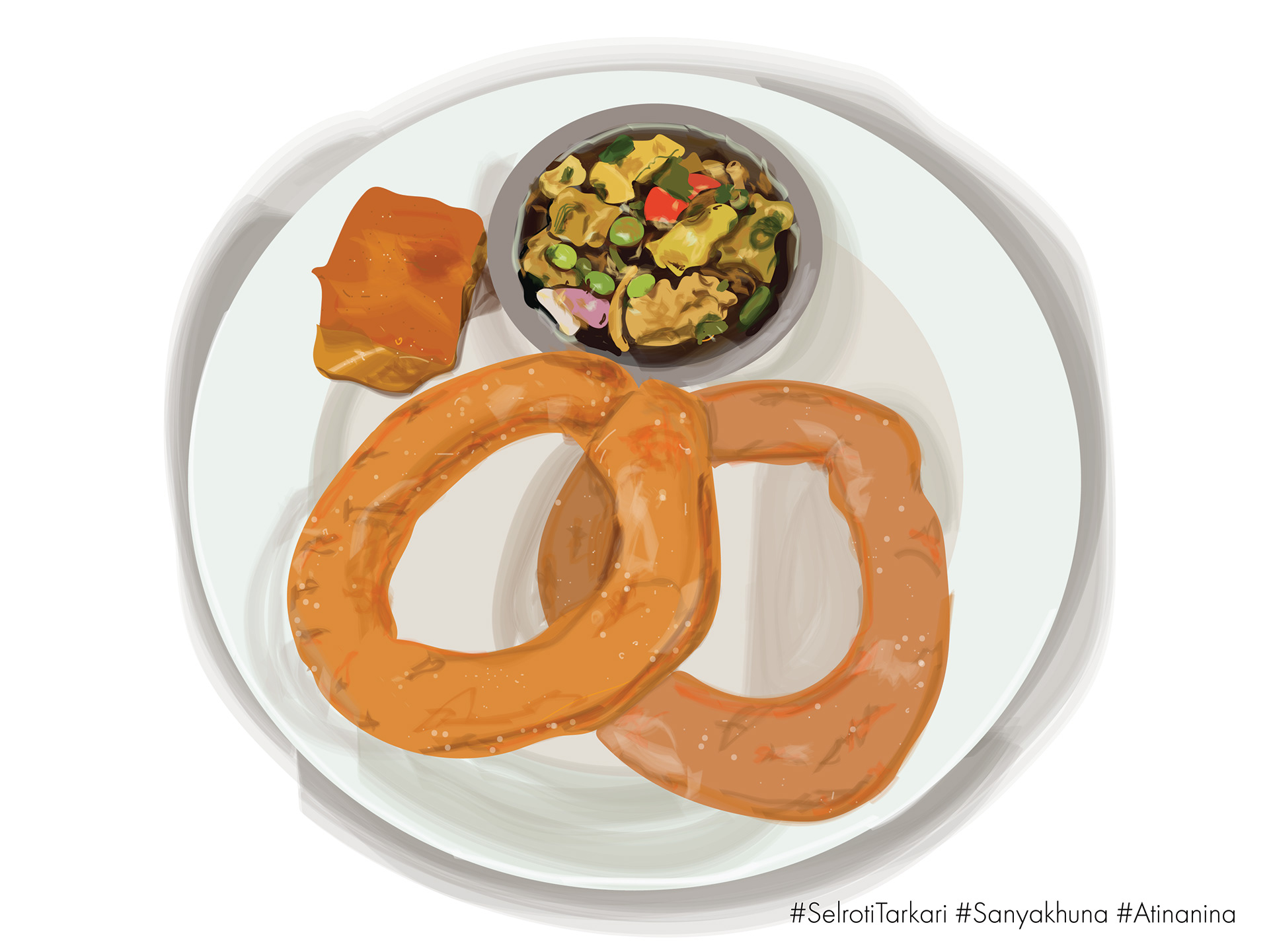
Selroti Tarkari, Sanyakhuna - Different families have their signature dishes and a unique way to prepare it. My family has the best way to make Sanyakhuna. It is juicy, spicy and has all the required flavors to it. We need a lot of tolerance of spice to eat this. I enjoy making Sel Roti which is made up of rice flour and consists of a sweet bread eaten with some potato pickles and vegetables. I am the one who is in incharge of selroti every time it is prepared. Sanyakhuna is a jelly made up of meat, fish, and spices. During the winter, it is the perfect dish to eat with lunch, dinner, and any other snack. It is one of the best meals I miss from back home. It is particularly prepared by the water buffalo’s meat.

Dal-Bhat Tarkari - There is a saying in Nepal, daal-bhaat power twenty-four hours, which means the portion is good enough to hold you for the whole day. It is a portion of everyday food for lunch and dinner in my country. Rice, lentils, vegetable or meat curries, leaf curry, tomato pickle, or any other pickle and some salads like cucumber and carrots.
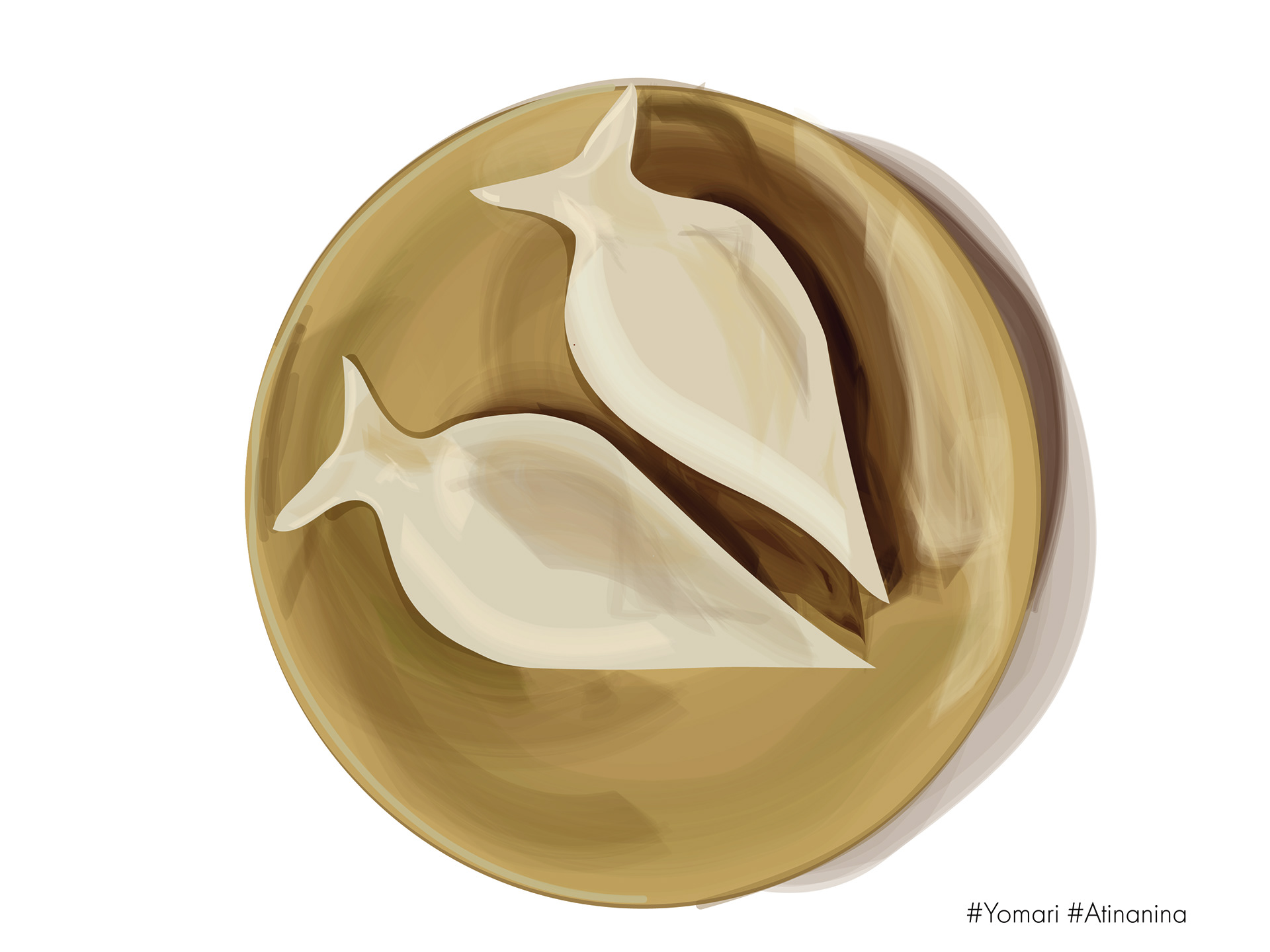
Yomari - It is a sweet dish, prepared by a unique Nepali sweet call chaku made up of sugarcane. It is dark brown and mixes with spices, sesame for the filling inside. It is specially eaten during the winters because the sweet heat the body from within to keep us warm in the cold days. My mom has the best recipe with the mixture of the perfect amount of the dry fruits and spices, I think she prepares them like ten times for everybody as a demand of every family member at different times during the winter.
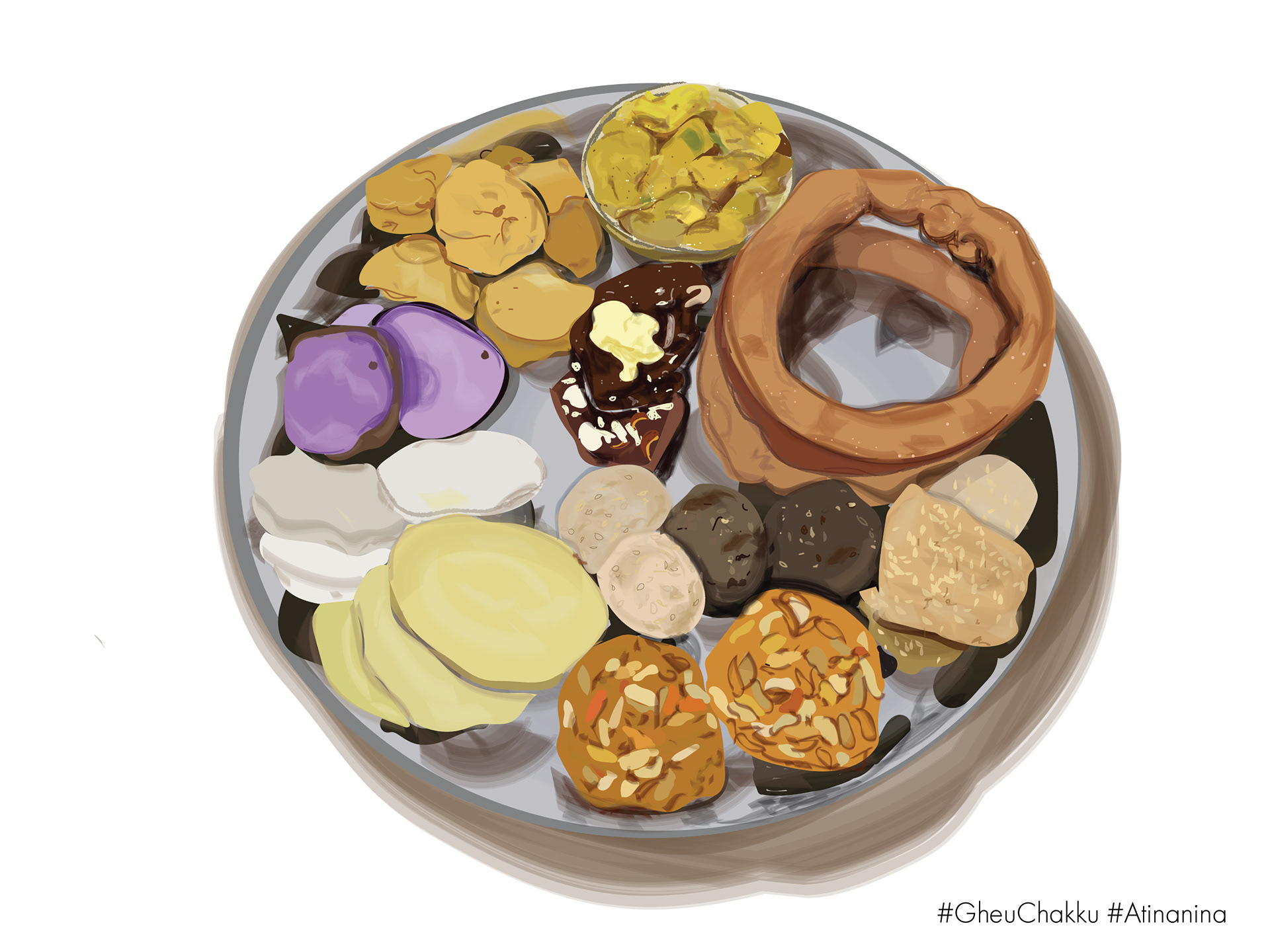
Gheu-Chaku Taula,, Tarul, sweet potato – It is a special day to eat all the ingredients like Chaku, Tarul, ghee, Sweet potatoes, sesame sweets, and my granny or mom add a tablespoon of oil on our head and pat to soak in with blessing to live healthier and longer life. I end up asking mom to massage my whole hair bathing in the sun with the sweets on my plate and enjoying it.

Puri Tarkari - Aluu puri – In most of the occasion, the morning breakfast and snack is using aluu puri that is potato curry and bread. It is the easiest and delicious to eat. I remember one time when we had to fast for some occasion and me being unressistance about the puri’s had to break my fasting. All sorts of puris are the best special when they are just cooked.
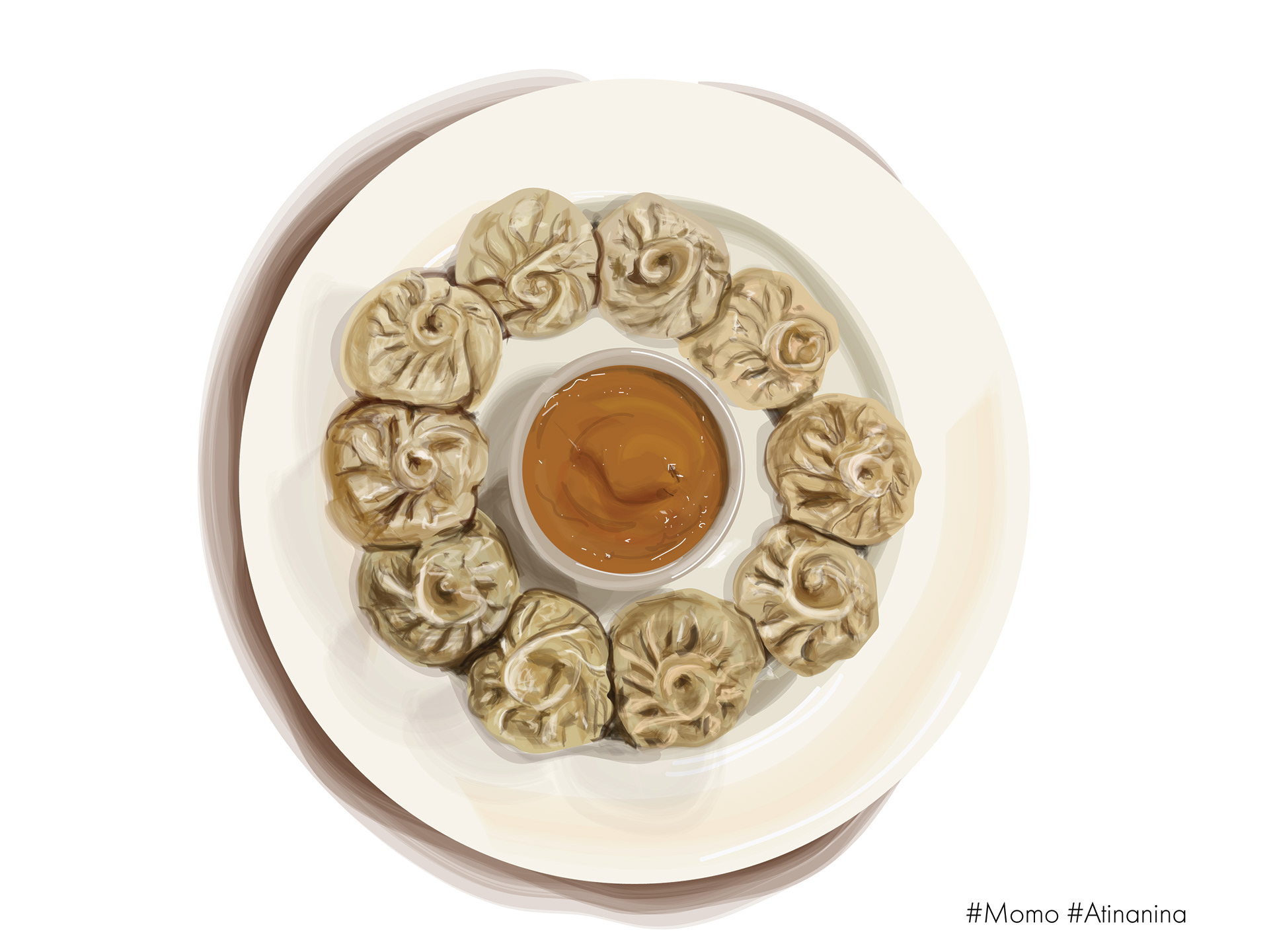
Momo – It is the one dish my family prepares like nothing else every day, any time any month, no matter what and we make the best momos in the world. We served it with a freshly prepared chutney/sauce of tomato and cilantro. Momo fillings vary like meat, vegetables, and whatever one prefers in their dumplings. It is dumpling but prepares differently with spices and ingredients. We normally prepare with water buffalo meat and vegetables.
Wheel Of Life
2020
Digital
11” x 8.5 “
2020
Digital
11” x 8.5 “
Life’s Cultural Journey
Life is marked by significant ceremonies that reflect our cultural heritage and personal experiences. This project visually outlines these rites of passage, capturing the traditions that shape our identities. Rooted in cultural authenticity, each ceremony holds deep meaning, preserving memories and symbolizing the continuity of tradition. Through this exploration, I share the richness of these moments, offering insight into their significance and the values they represent.

Rice feeding – Pasni – Annaprashan- weaning ceremony This ceremony is performed when a baby turns six months, up to one year old. It is a transitional phase between breastfeeding to food other than mother’s milk. The baby is dressed in traditional clothes for the first time they feed milk and rice. All the close families come together to feed the baby with other dishes prepared on the day. They don’t feed them all but pretend to feed as a ritual. Every family member feeds the baby with a silver spoon as a symbol serving it in pure form and not contaminated with others. The baby receives gifts, clothes, and toys as a blessing from everyone. During my rice feeding, according to my family, the ceremony was done in my nearby temple in front of the god, and few family relatives were present to feed me. I hardly have any memories as I was tiny.
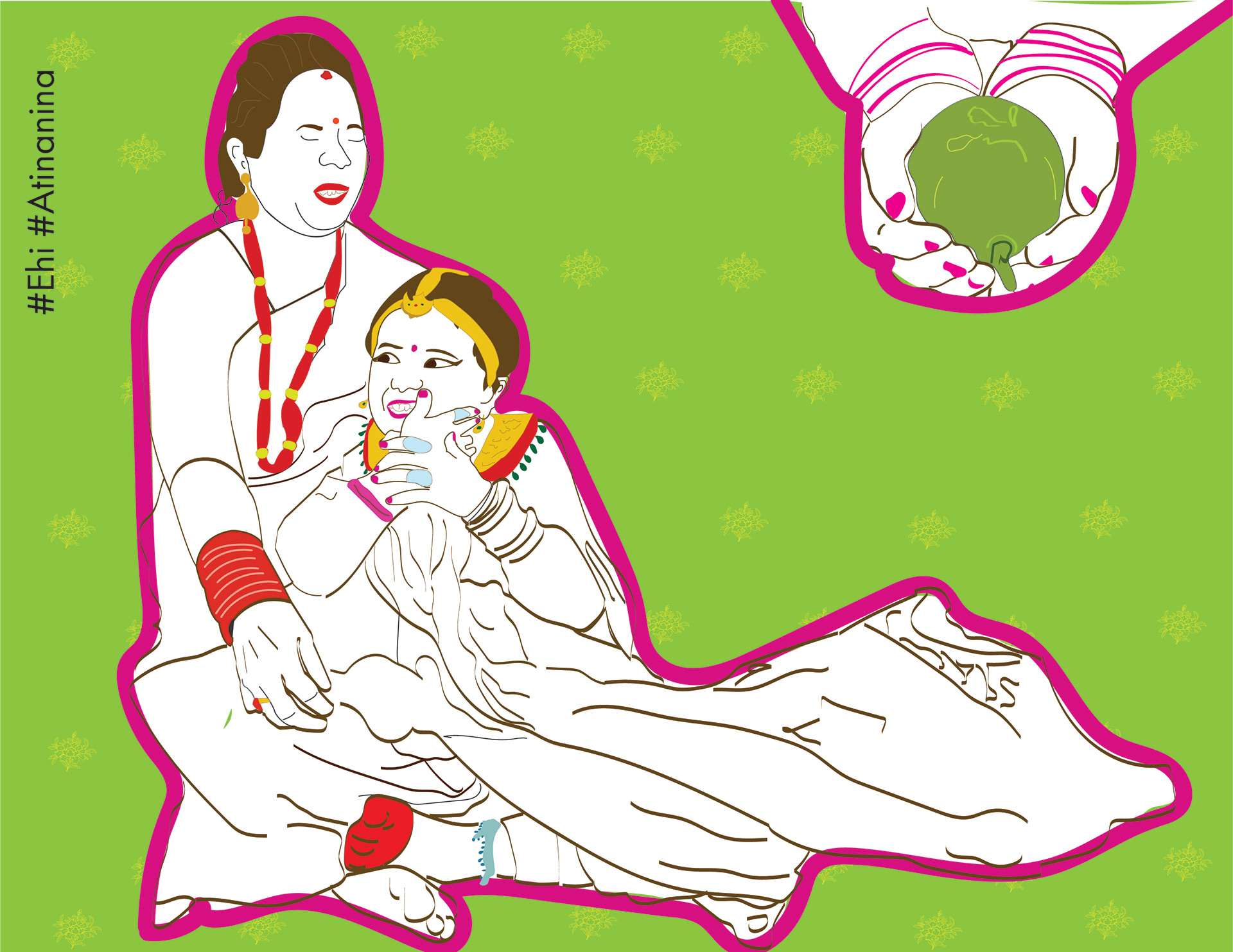
Ehi- Marrying a fruit/wooden apple This ceremony is for pre-adolescent girls marrying a fruit called bael (golden apple/wood apple). Bael is a special kind of fruit that never rots or decays, it also symbolizes the Hindu god Vishnu. It is believed that, if later in her life, when she is actually married to a man and if he dies before her, then she will not be a widow. Long ago, there was a tradition of going sati ( wife scarifying herself when her husband dies). So, this tradition of marrying a bael allows her to live a healthy life with colorful clothes after her husband's death. Otherwise, she would be wearing only white clothes as a widow. Usually done at the age of 7-8 years old, which is said, a virgin girl handed over to god, and the girl gets to keep the fruit with her for life as it remains the same forever. I was seven years old when I got married to bael. It was a different feeling of being married at such a young age. Honestly, I was excited to dress as a bride and do what I was told to do. It didn't bother me. The importance of the marriage wasn’t evident then, but as a kid, we all know that this happens because we see some relatives having their daughter’s ehi. When my Ehi was done, I remember one of the girls became close to me as five other girls performed the ritual along with me during the event. So, she became good friends with me, and when we were asking if we wanted to become friends for life, we both agreed, and that’s how I have a Mitini. Mitini is a special bond of two friends that build a relationship like family for life. Both the male and female are allowed to make mit or mitini once in their life, and they will be there for you no matter what every event of the family organizes. They hold an essential relationship with the family. My mom still has the wooden apple, my so-called husband safely somewhere in her closet with my other tiny jewelry, clothes that I wore during that time. I don’t know why, but it is a very emotional thing for a mother because my mom gets into tears every single time, we talk about it.

Bartamanda- Upanayana/Janeu It is a ritual where the boy’s hair is shaved, and he is stripped to naked and a special kind of cloth used to cover his genital part considering him into manhood. In this ceremony, the boy promises to his great grandfather, grandfather, and father to stay home and perform all the ritual practices while studying, earning, living and performing ritual rites of the family). The maternal uncle plays an essential role in guiding the boy on the correct path and direction in life. If he is lost, there will be a small event where the boy runs away, and the maternal uncle catches or finds him in the family. I remember my brother’s ceremony. He cried while shaving his hair, and all of us, including my cousins, we all cried with him. When I think now, it seems silly, but it was an emotional moment. My great grandfather performed some offering, and while he was blessing my brother, he also cried so much with happiness. The ceremony Ehe and Bartamanda are different and have a different aspect to it, but since my brother and I are two years apart from each other. Recalling some memories, my brother and I had to go to school during one of the events, and we were late for the class. I still remember standing in the principal’s office. For my brother, he got more gifts like the video games and other fancy games to play, as siblings, we always fought for the gifts we got as a kid, but we also share a special bond now.
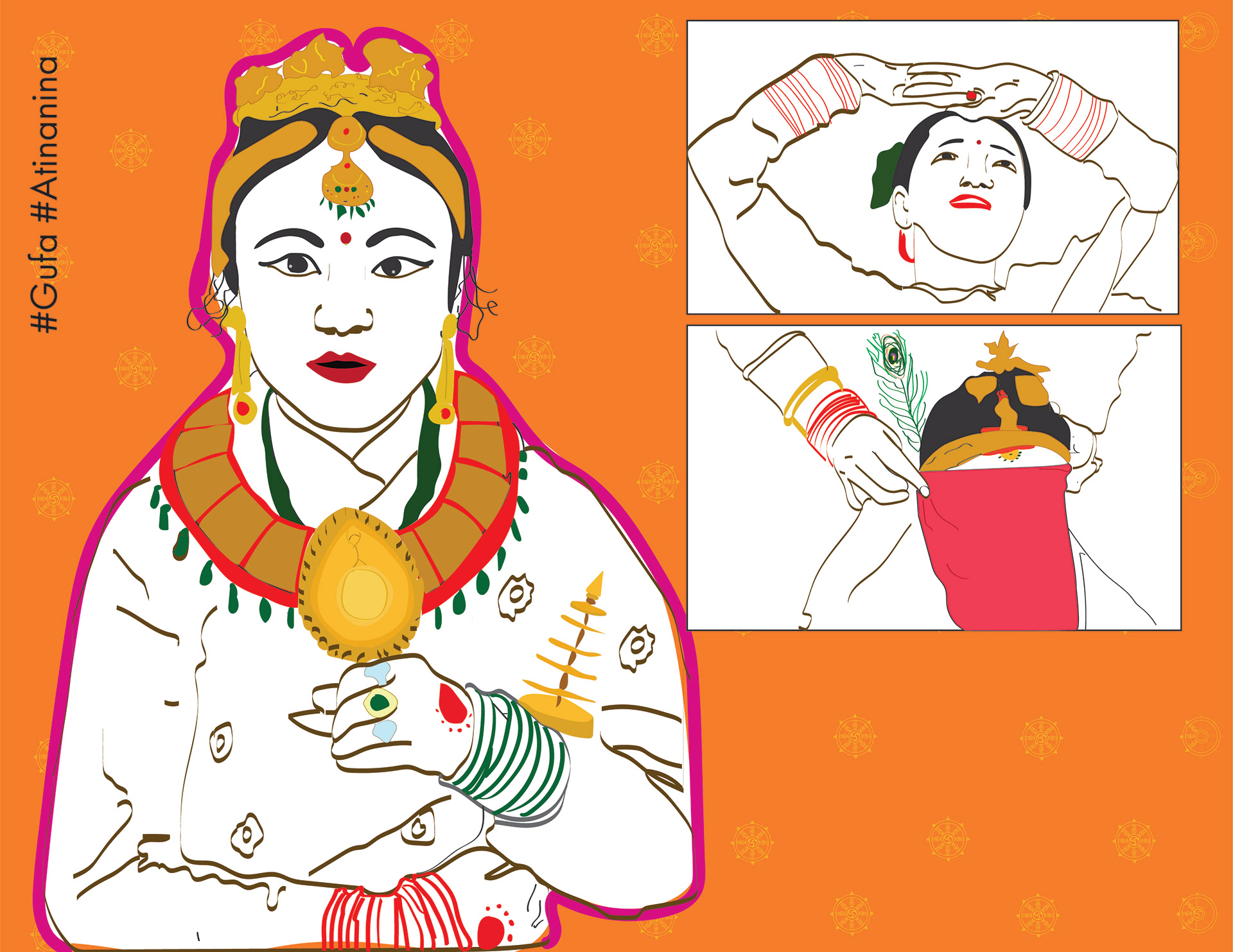
Gufa- Bahra - Marrying sun/Surya bihe The ceremony was done when I was roughly ten-year-old. It was an evening time when it was decided that I will be in a dark room for twelve days. I was terrified of the idea of not able to see the light and come out of the room. I was not even allowed to see my brother, dad, grandfather. No men were allowed in the room and strictly kept in the place. My brother got me some cassettes of music and some games to play while I am inside. The fun part was females’ friends, cousins, and relatives were allowed inside, and they would get me fruits and food that I like. The other exciting thing that we would do is scrub ourselves with the special powder made up of sandalwood, chickpeas flour with mustard oil, and some water. It is a traditional way to do it while we are in the room. We also played a stone game; it was one game that was fun to play during that time. The most sacred part was the Khayak, a doll made with cotton wool because it is symbolized as the protector while you are in the darkroom, but the thing was the scary stories everyone shared. I was scared every night for twelve days. On the twelve-day, I got the dress like the bride and the first thing I saw outside because my eyes were covered with a cloth, was the sun with my finger crossed in a certain way. I was married to the sun after that and believed that I would never live a widow life after my husband dies. It is done before the age of menstruation. The same evening, my family threw a party for all, and everybody got me gifts, and I finally got to meet everyone as an average person.

Bihe - Wedding I haven’t had the opportunity to get married to a man yet, but I have had the experience of wedding ceremonies of my best friends, cousins, and relatives. It is a lot of work and brings everything together. The wedding lasts for a week with different ceremonies from the bride’s family and groom's family. It is an emotional time for the bride’s family and friend because she is given away to the groom. The most exciting part is when the groom arrives with the band's loudest music with his family dancing to the bride’s house to perform the marriage ritual and take her with him the same day. It is a sad and quiet atmosphere after the bride leaves home. As a bride's friend and my other friends went with her to support her in her new home. We stayed till another ceremony lasted and left later at night. There are so many sarees, and jewelry brides have to change and fit into every day during the wedding, I was tired myself running around helping her and her mom. My friend was complaining about the weight of sarees and jewelry. It is like a dream until I have to face it because I was there with my friend, we cried while she left with her husband, but I don’t know how it will make me feel when I have to marry and leave my family.
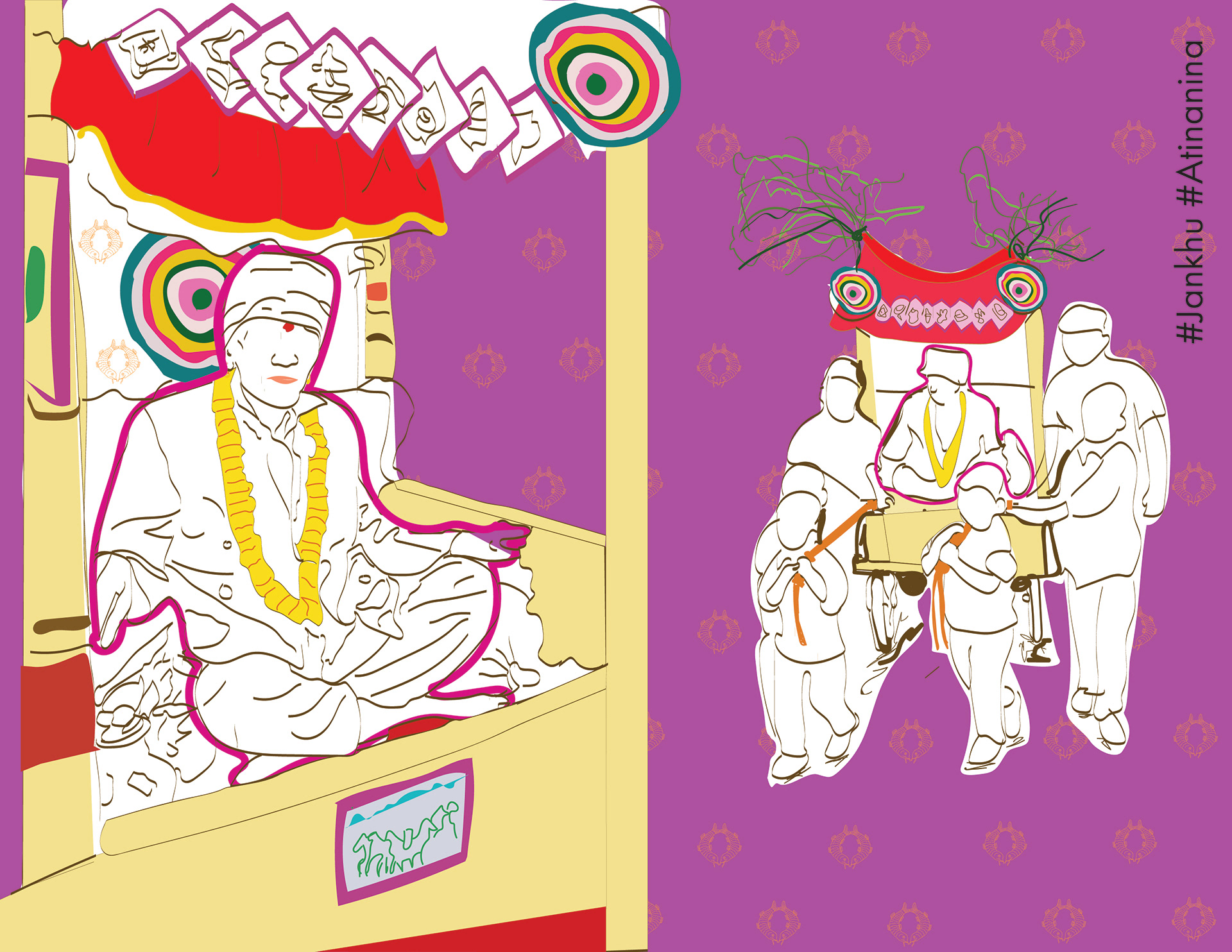
Jankhu Janku is a celebration performed when members of the Newari community turn 77 years old. There are five Jankus performed during the lifetime of the person if s/he happens to live up to 106 years old. First Janku happens at the age of 77 years, 7months, 7days, second at the age of 83 years, 4months, 4days, next occurs at the age of 88 years, 8months, 8days, fourth Janku happens at the age of 99 years, nine months, 9days and the last one at the age of 105 years, 8months, 8days (after one has seen 1000 full moon in their lifetime). I got to see two of the Jankhu of my Grandfather and the first one for my granny. They were the god and goddess after their first Jankhu. So, they are forgiven for all the mistakes they have made so far in their lives. It is a birthday celebration with extra effort with the ceremonies that involve a lot of materials, particular clothes, items, jewelry for the event. It takes weeks and months to prepare for this event. My grandparents, in their first Janku, were nervous when they had to dress again as a bride and broom. They were more socially shy and less expressive until the moment when we did the ceremonies. They both cried with the pride of feeling that they could live up to this age and celebrate with their families, great-grandchildren, grandchildren, and close friends. Since we did this at home, there was a lot of responsibility in preparing the food, arranging the ceremonial altar, making sure all the guests are fed well, everyone is getting the attention, and after the ceremony. We have to send sweets to families who attend the events as gratitude for visiting.
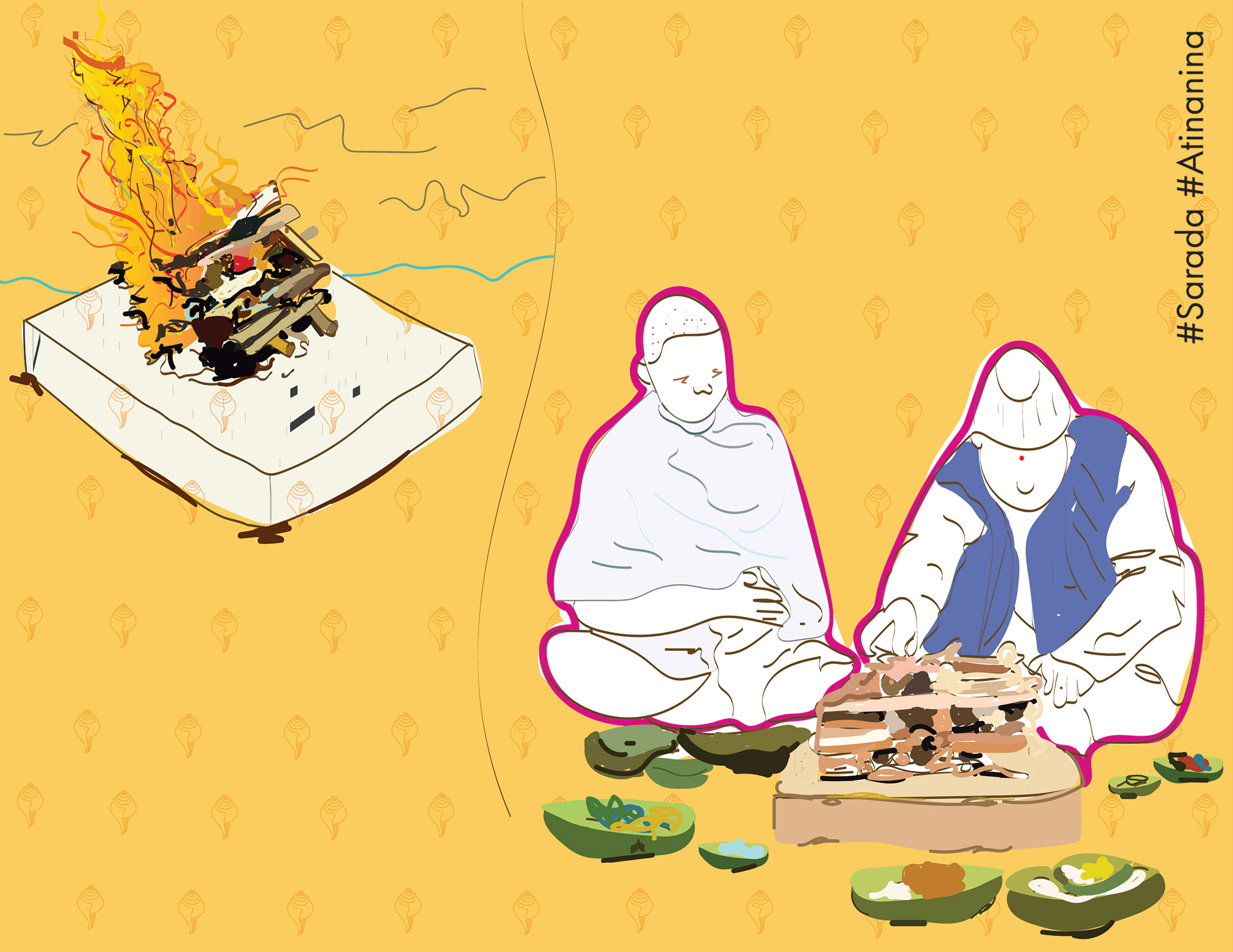
Death – Death cremation and after ritual Sarade The unhappiest ceremony that we perform during our life when our family member dies. It was heartbreaking to face this moment when I lost my granny. She was taken to the Pashupatinath ghat, a cremation place. It was hard to believe that she was gone. In her memories were a ritual called Sarade with the priest every month for a year. My dad performed all the rituals as the elder son of the family; he wore a white dress and didn’t participate in any other event apart from Sarade for a year. At the time of my granny’s first death anniversary just a day before, we had a big earthquake. Due to which we had to postpone her anniversary for a month. I lost my grandfather too when I just got here in the United States. Unfortunately, I had missed all the monthly rituals but managed to attend one of them during the winter when I got back home. It is hard to believe that they are gone, but all the rituals that we perform in their names makes our prayers for their soul. I think they're both with me sending their blessing to me all the time.
Eight auspicious symbols
2020
Digital
2020
Digital
Eight Auspicious Symbols: Cultural Significance & Personal Connection
The Eight Auspicious Symbols play a vital role in festivals and traditional rituals, each carrying deep symbolic meaning. My fascination with these symbols began in childhood, inspiring me to reinterpret them with a deeper understanding. They are designed to be placed on door sidewalls and serve as a gateway to positivity, honoring their cultural significance while creating an inviting atmosphere.

The endless knot – It is an ornament that symbolizes never-ending, its pattern continues. It is auspicious and represents the connection to fate, karma, and destiny.

The Vase/ Kalash – It is a special kind of water or treasure pot that holds the precious and sacred substances to attract wealth and spiritually store them.
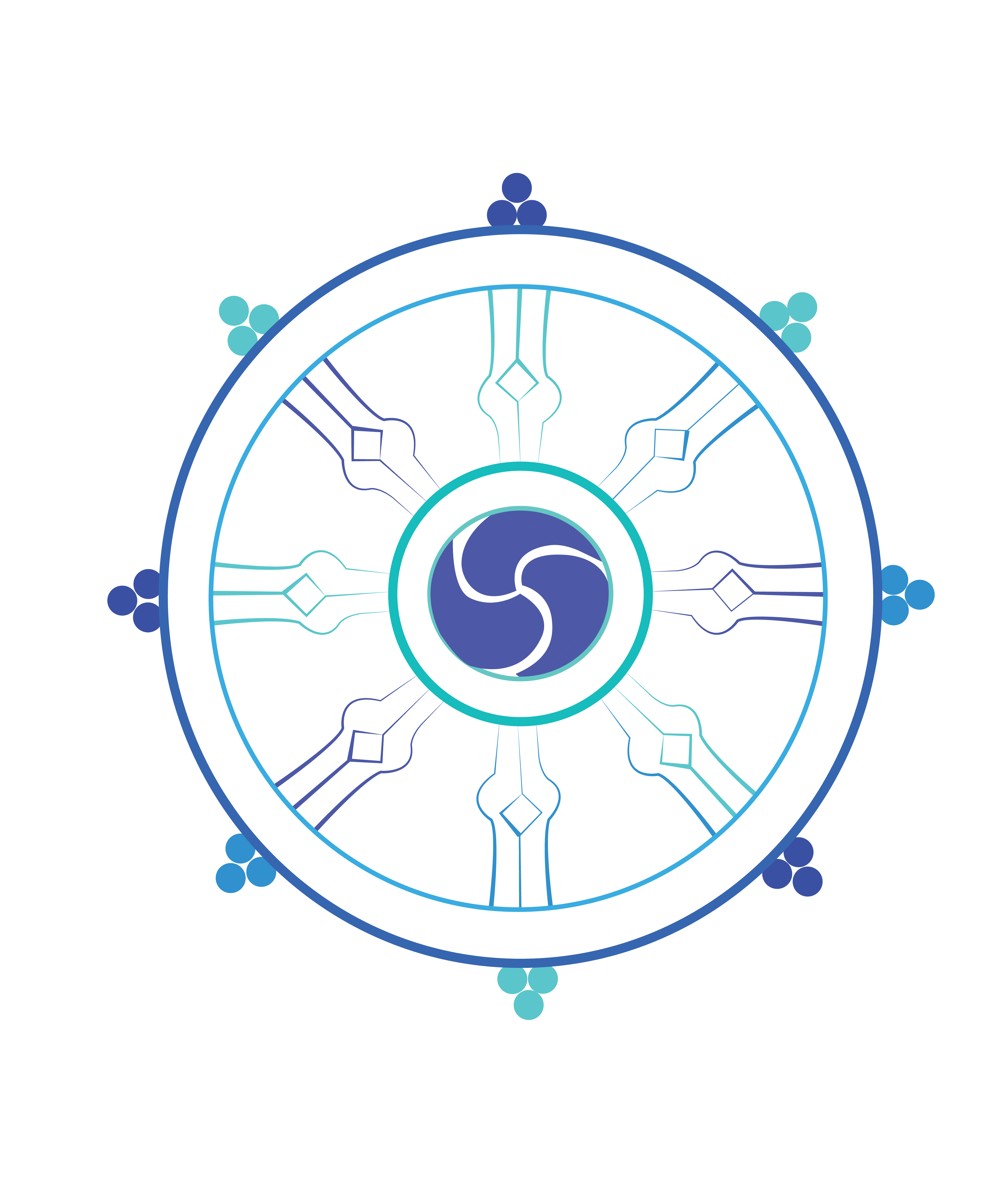
The eight-spoked Dharma wheel – It represents the limitations of life as we live in the mortal world. The wheel of transformation is the wheel of law, what goes around, comes around is a saying we believe in practice.
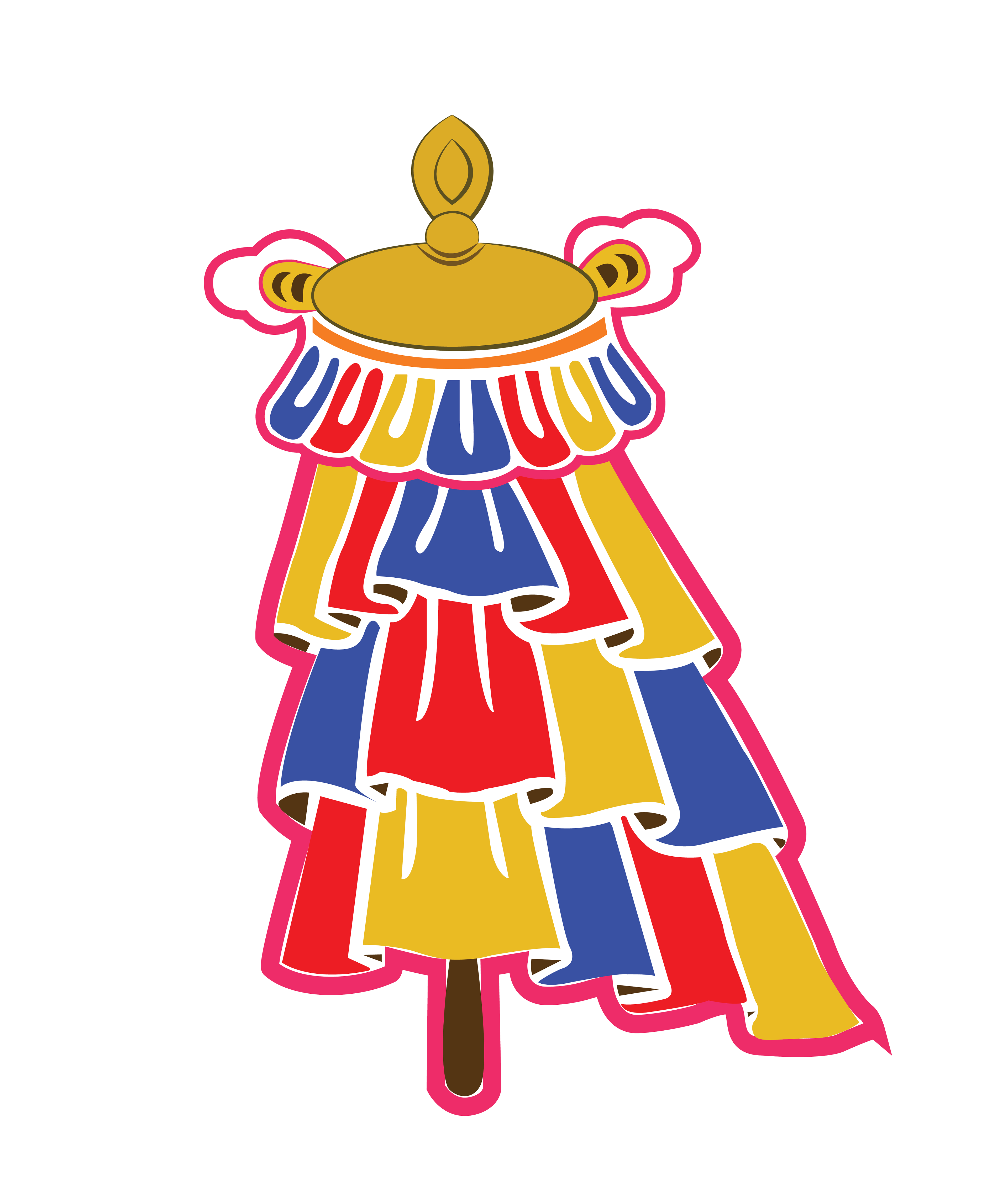
The victory banner – It is a banner that carries the ancient significance of wars and victory. After finishing the war, raising the flag is the sign of victory, now used as a symbol of success over evil. It also symbolizes enlightenment and knowledge over ignorance.
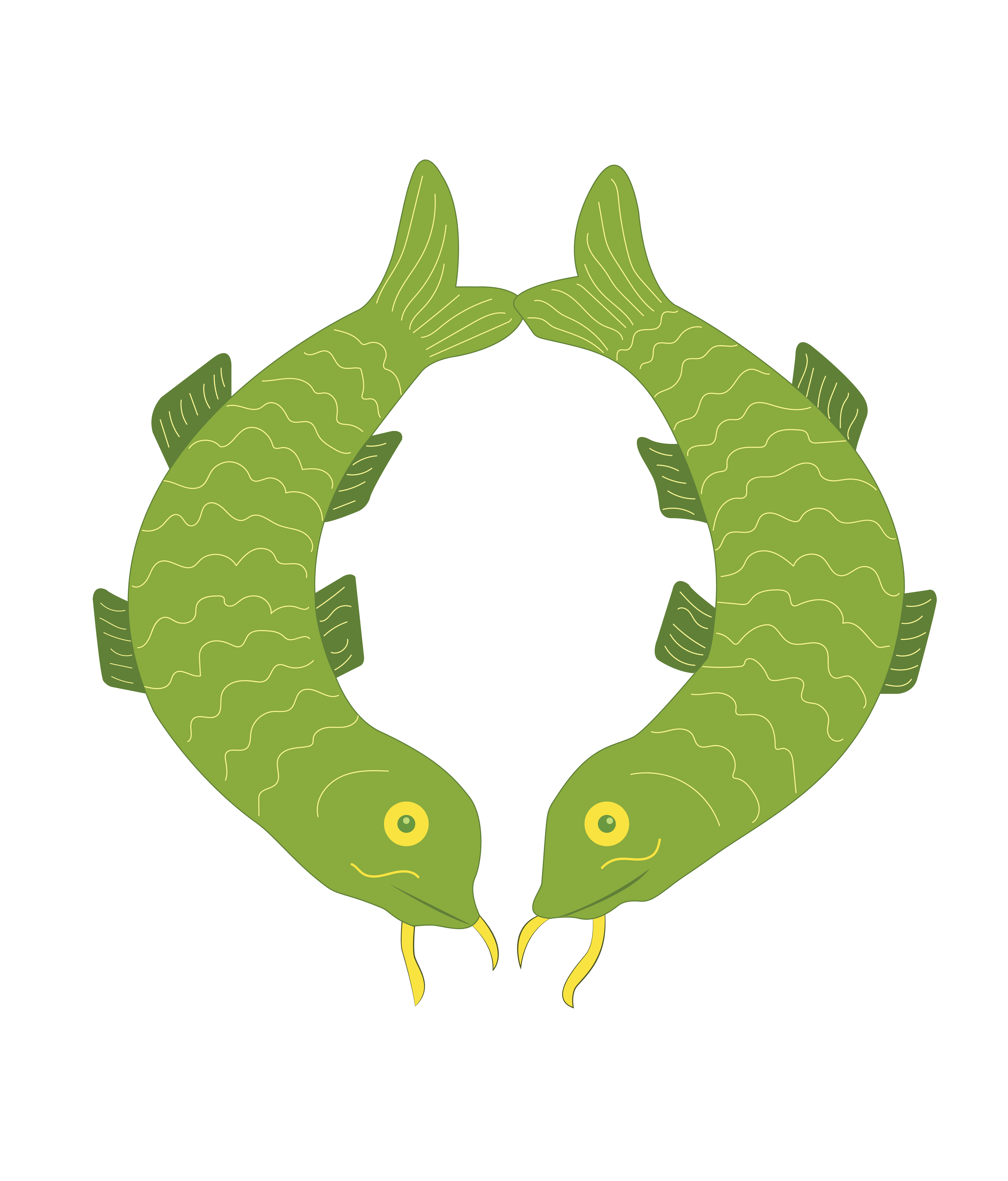
Two Fishes – the pair of fishes are symbols of two sacred rivers, Ganga and Yamuna. The two rivers also represent the lunar and solar channels. The two fishes also symbolize happiness and use in wedding for the newlywed couple to have a happy married life.

The conch shell - It is original horn-trumpet; ancient Indian mythical epics relate heroes carrying conch shells. It is used on special occasions by blowing it loud to remove the negative energy with the sound.
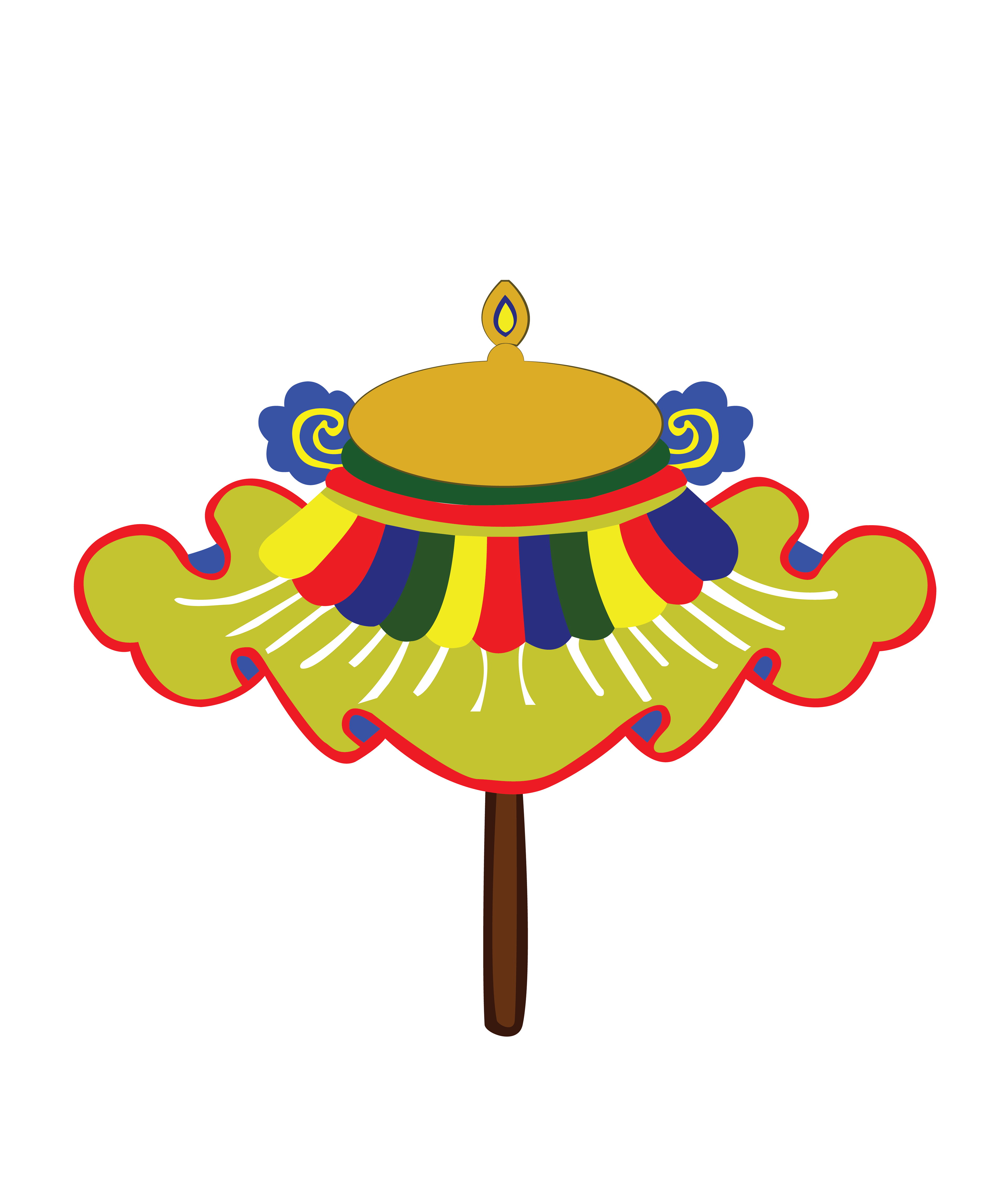
The Dhorg- an umbrella/ parasol – it is a symbol of protection and royalty. It symbolizes the ability to protect oneself against various elements like the weather, sun, rain, and others. These special made umbrellas are raised during multiple festivals as the god is carried and walked around the town.
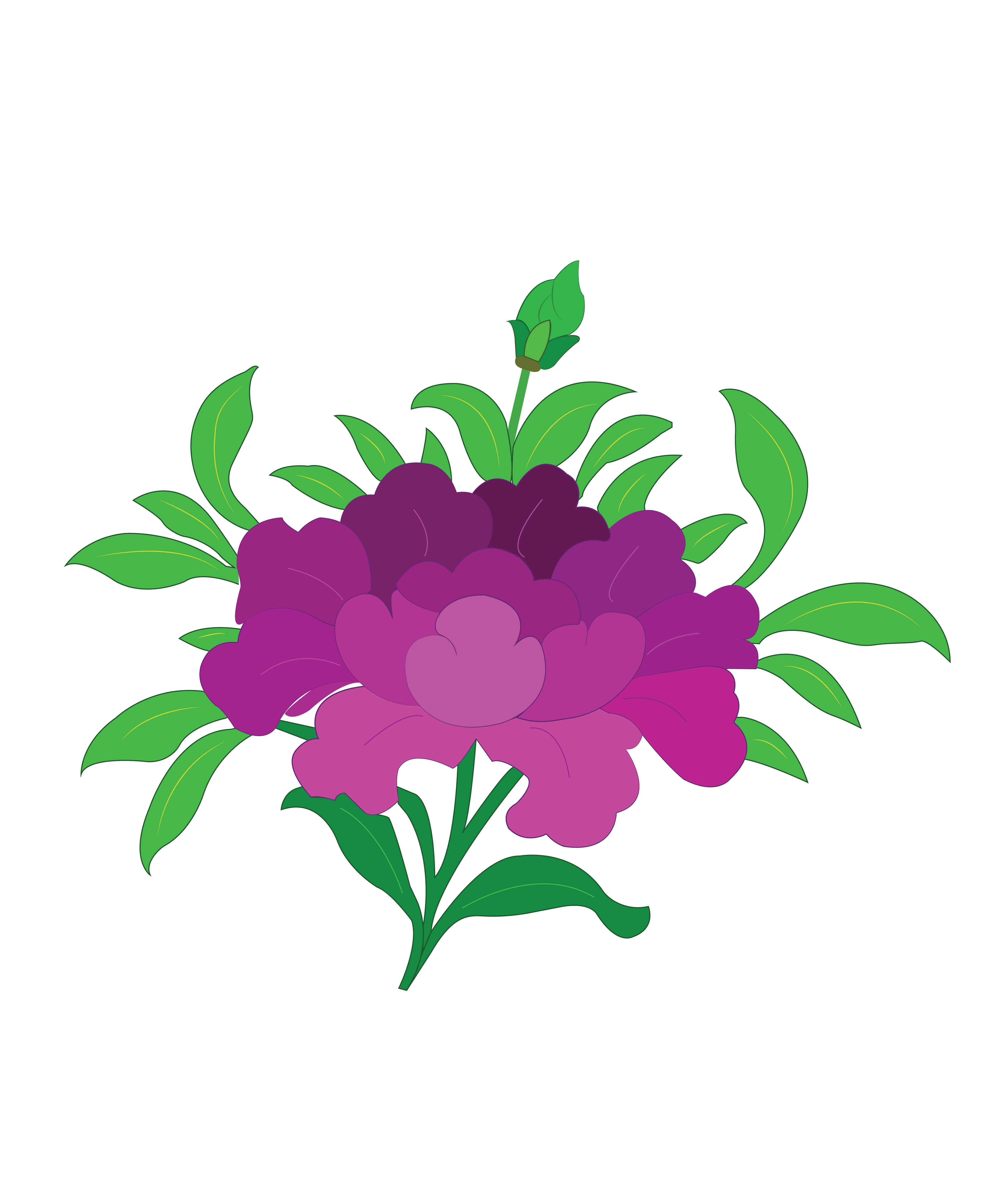
The Lotus – Lotus is an auspicious and divine flower because it grows in mud. Even though it is grown in dirt, it blooms bright and without fear.

Om – It is a symbol seen everywhere in Nepal as a symbol of the divine, good luck, and a new beginning. The vibration of the sound om manifests the connection with god. Om drawn with the holy powder on the doors and water symbolizes positivity and good luck. It represents the divine energy of three gods, Bhrama, Vishu & Maheshwar, the trinity of Hindu gods that summarizes all the other gods.

Swastika – the swastika symbolizes the sun, prosperity, and good luck it is written with om at the doors. The clockwise sign is a symbol of the sun, and anti-clock means night.
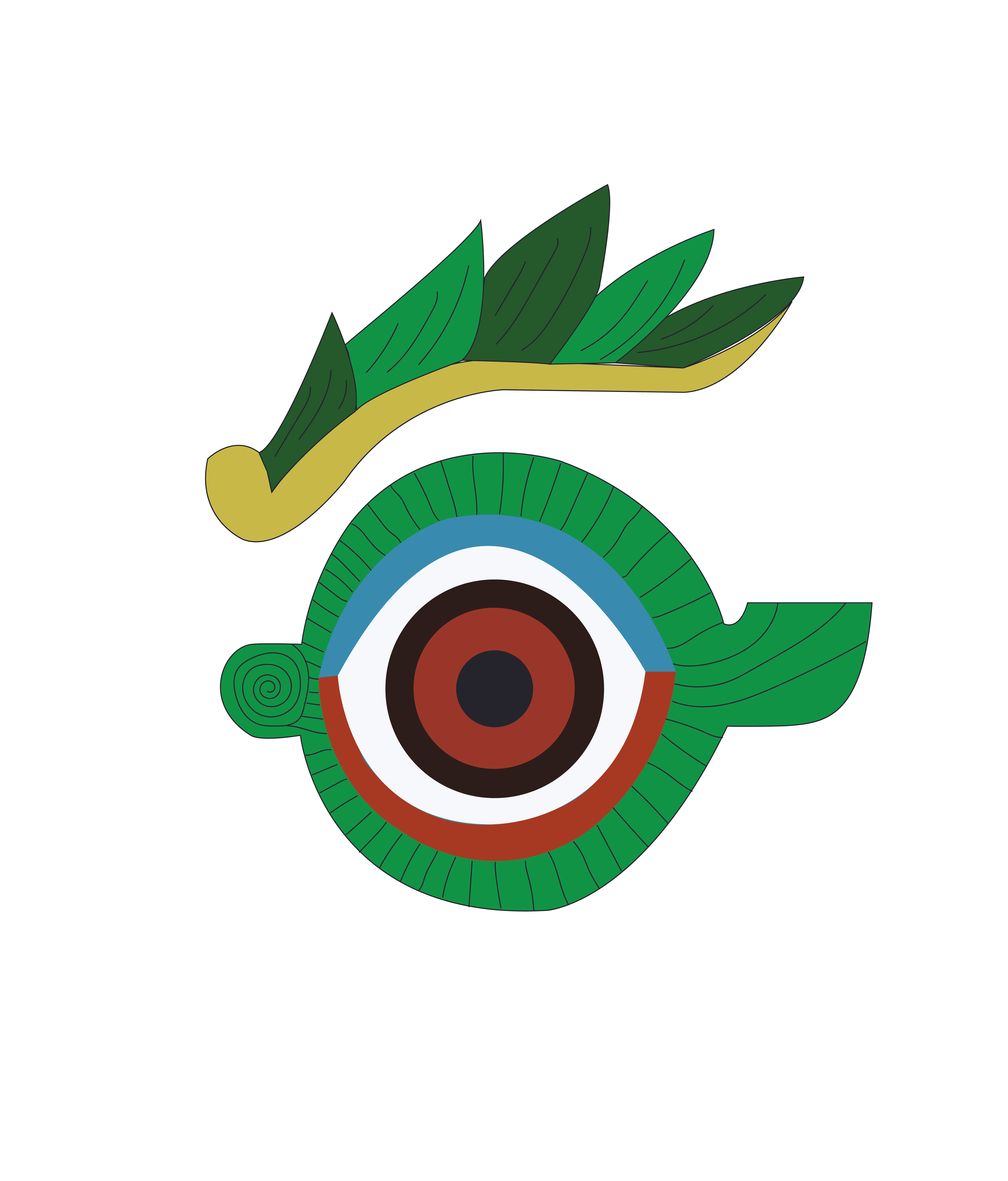
Eyes- a decoration is done at the door, to keep the evil eyes out of the door
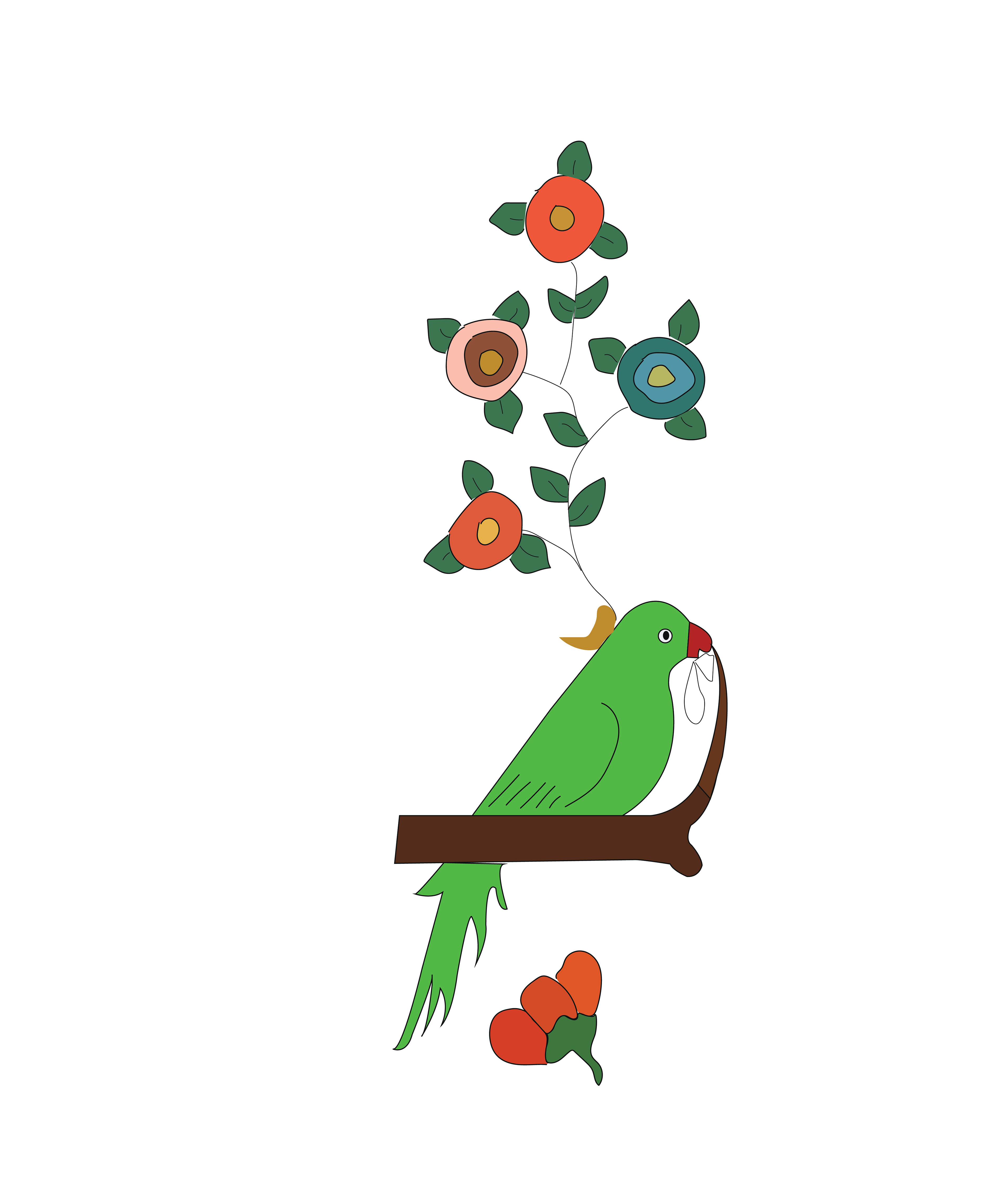
Parrots - another decoration piece use to make it look prettier.
Altar: A Sacred Space
The altar serves as a shrine for deities and a space for ritual practices like puja. As part of the exhibition, it is an artifact that enhances the spiritual atmosphere, complementing the design work. Ganesh, revered as the remover of obstacles, is always worshipped first in any ritual.
a outline for laser printer on wood, below are some artifacts for the display to present the idea into a installation
